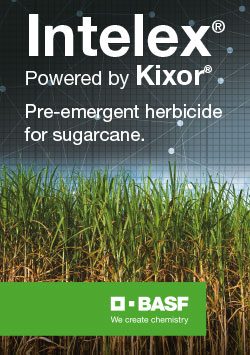Yay! It’s finally time to share what I learnt from one of my most favourite JAFFs. I was lucky enough to be based at his B.E.A.U.T.I.F.U.L. lodge near Louis Trichardt in Limpopo while I interviewed a few other farmers nearby. For a closer look at my temporary nest, read through to the end.
Having businesses in multiple sectors, from commercial product development through to chairing organisational bodies and investing in development, JAFF is an accomplished all-rounder. I still have no idea how he does it all … and does it so well; even now, as I scroll through the valuable communication we’ve had since our interview, I am amazed at how much energy he has selflessly invested in sharing extra info that has made this story one of the best ever.
Grab a cuppa, we’re about to get learned!
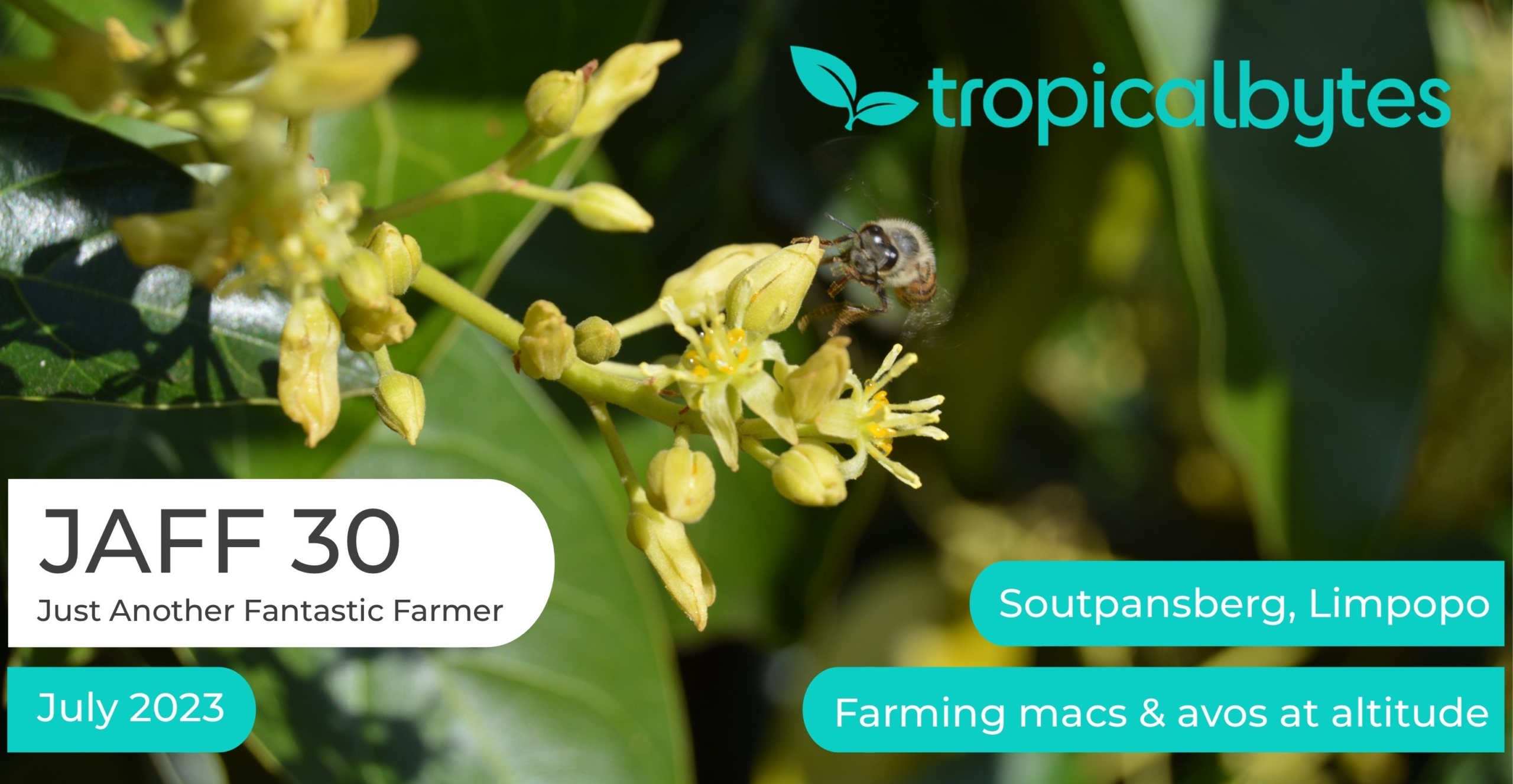
| FARM CONTEXT | |
| Date of visit | 12 September 2022 |
| Area | Louis Trichardt, Limpopo |
| Soils | “Excellent” Mostly Hutton with a 30% clay – slightly lower than normal – which is perfect for avos, some Clavelly. |
| Rainfall | 1000 – 1100mm annually in a mist belt. |
| Altitude | 1400m |
| Distance from the coast | About 600kms |
| Temperature range | Warm Wet Season (Dec–Feb). 16°C to 40°C.
Cool Dry Season (May–Aug). 12°C to 22 °C. |
| Varieties | Fuerte, Maluma Hass |
| Hectares | 150 ha avos inc new developments. Plans to grow to 230ha avo |
| Diversification | 50 – 60 ha macs and growing.
Mac & guava nursery. Numerous other business interests. |
Although JAFF’s career has been diverse and far-reaching, geographically he hasn’t moved far … he grew up on a farm in the Levubu Valley, less than 40kms from where we are today.
In 2005 that farm was sold as part of the mass land claim in that area. JAFF was involved in brokering that deal as he felt resisting the inevitable was futile, especially given what Zimbabwean farmers, less than 100kms north, had experienced. 50% of the Levubu valley, about 19 farmers in total, all sold out at the same time. Most adopted an “as little as possible” approach to their farming when they knew they would no longer be curating the land long term.
JAFF was involved with one of the Macadamia processing companies until around 2008.
SOUTPANSBERG FARMS
JAFF had an uncle who had inherited 2 spectacular farms at the top of the Soutpansberg Mountains; but he was involved in the legal fraternity in Pretoria (now Tshwane) and had limited knowledge of farming. JAFF worked with him to develop the land but Oom was very cautious about every decision, fearing that his high profile would be tarnished if he was seen to have failed in agriculture, and it was tough-going. When he passed away in 2017 JAFF took over in the driving seat and is now on a purposeful path to developing the arable area and conserving the inarable portions.
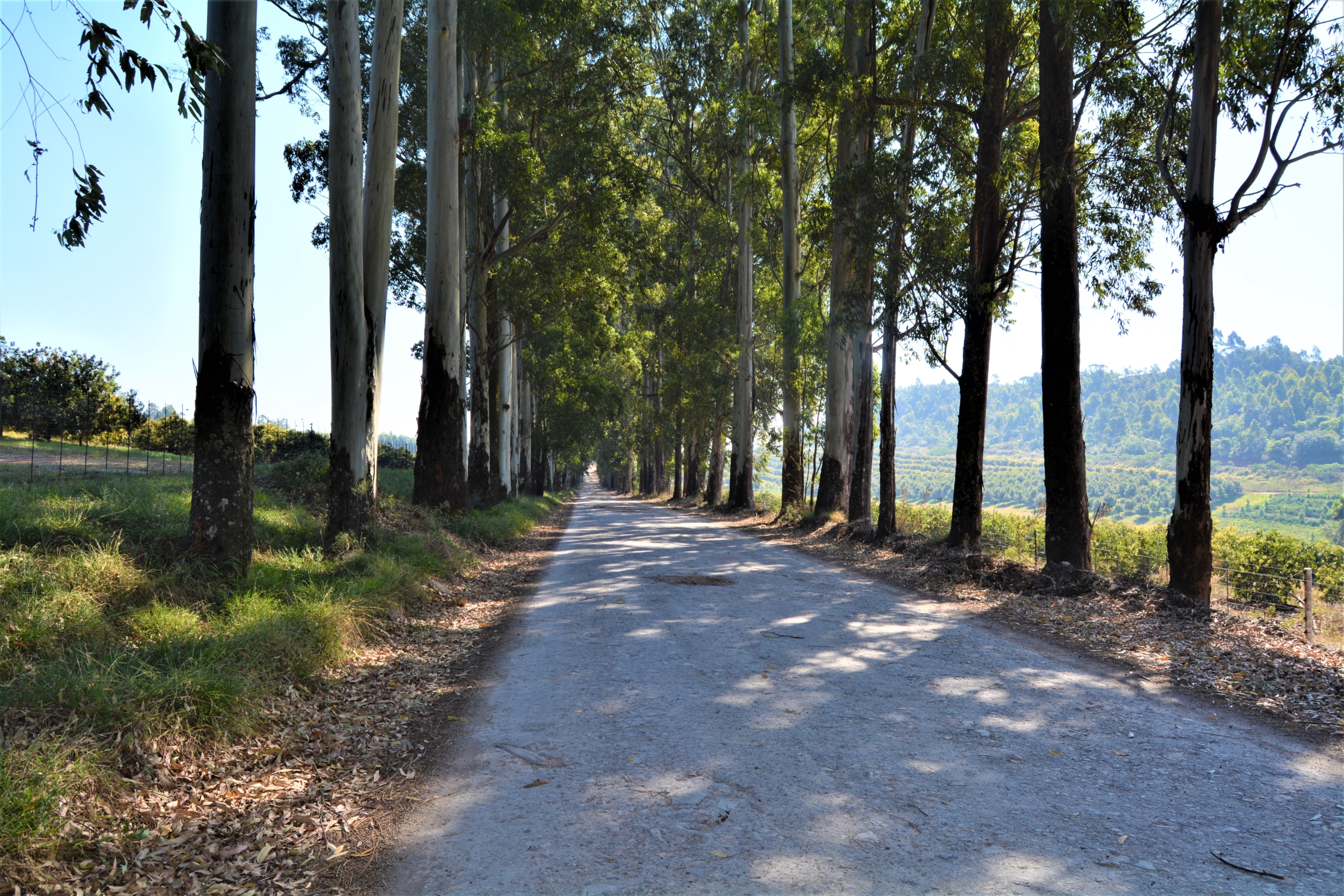
Drive up to the spectacular farm. The commercial farmer in JAFF wants to cut the blue gums down because they consume so much water and their shade ruins the first row of trees in the neighbouring orchards but this avenue is so popular with locals and photographers that he hasn’t been able to do it yet.
I found the history of these farms fascinating so, if stories are your thing too, join me …
In the late 1800s, during the Anglo-Boer war, a medical doctor, Dr Hay, came to South Africa, from England. After the war, the British appointed him to help the Boer re-establish themselves and he received these 2 farms as a Crown grant for his efforts. He lived on the one farm, in an old wooden house, which JAFF remembers seeing when he was a boy. Dr Hay planted veggie gardens, built canals, grew apples, peaches, plums and pears. When he passed away, JAFF’s grandfather (also a doctor who practiced in the town) inherited the farms. Even though they came with an overdraft he took them on and planted avos; many of which are still producing today. JAFF isn’t sure exactly how old they are but it is in excess of 65 years. These are some of the first avos in the Louis Trichardt area.
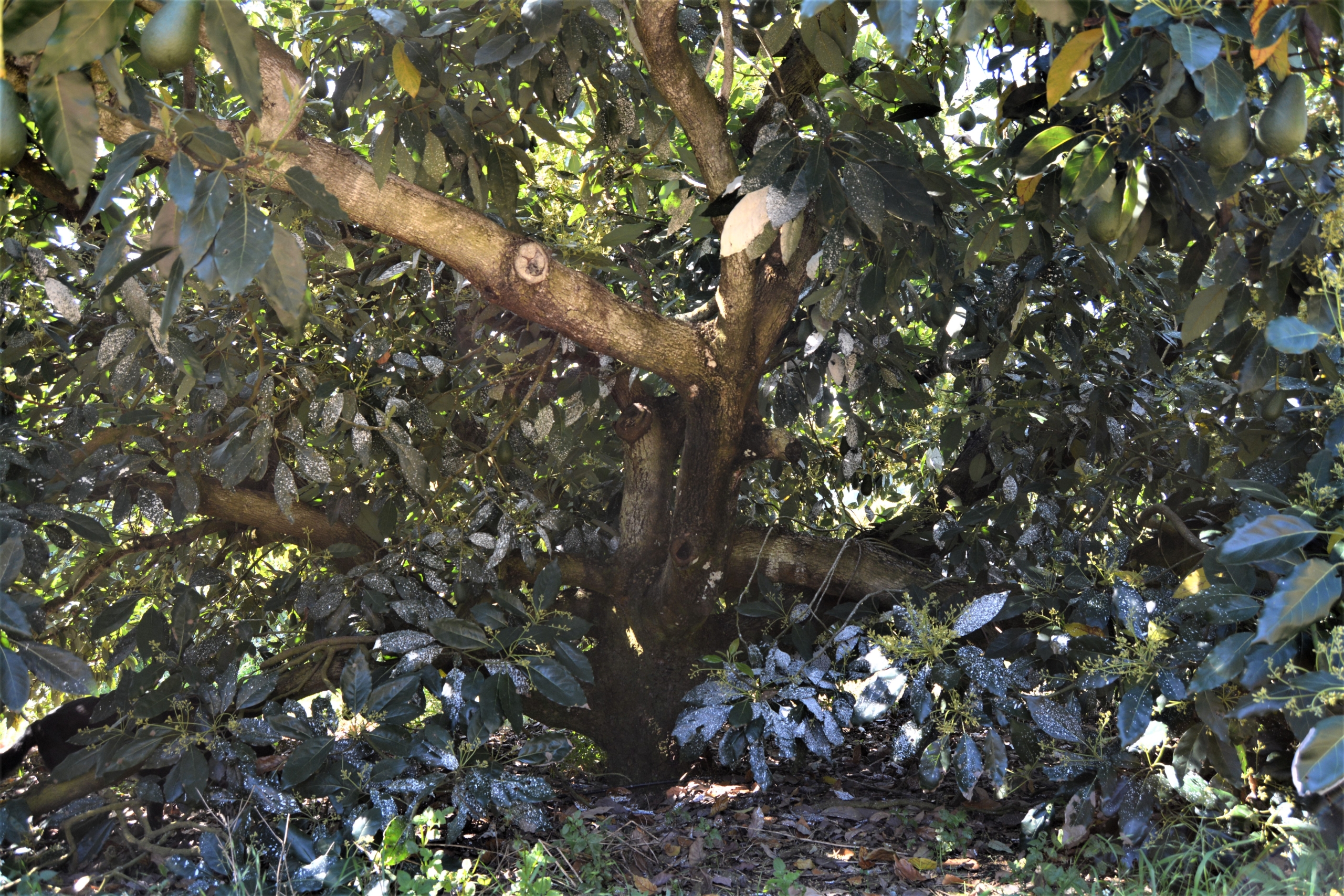
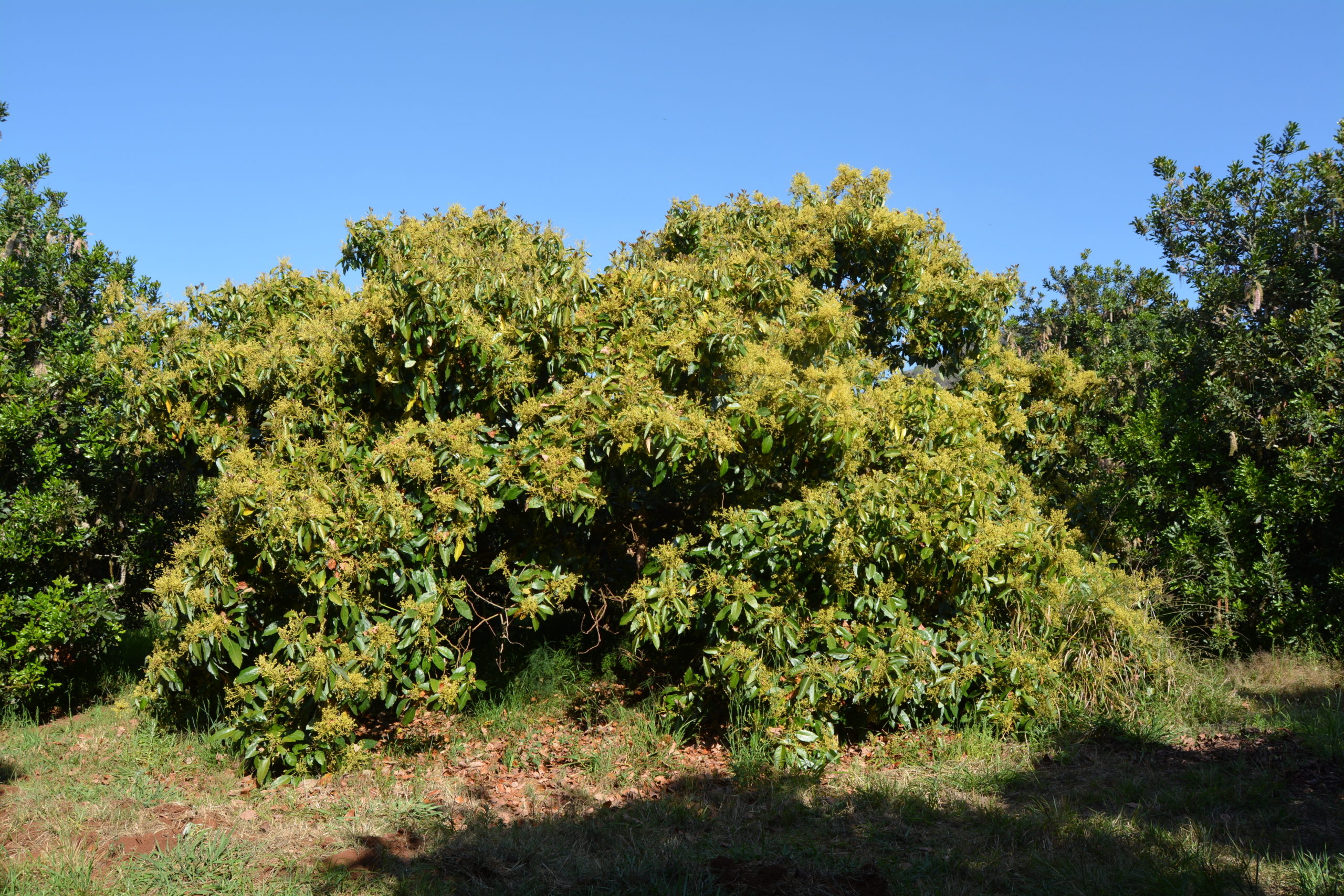
60+ year old avo trees planted by JAFF’s grandfather
Each farm is about 550 hectares. One is named ‘Highfield’ & the other; ‘Rocks on Stone’. Rocks on Stone is just that and is pretty much inarable. It adjoins a conservancy and, along with many other ‘farms’ along the Soutpansberg, it is part of the EWT-coordinated natural reserve. Half of Highfield will also go into that conservancy. JAFF (thankfully) is an outdoor, responsible human and believes it would be selfish and criminal to commercialise this virgin land. There’s plenty to keep him busy on one half of Highfield.
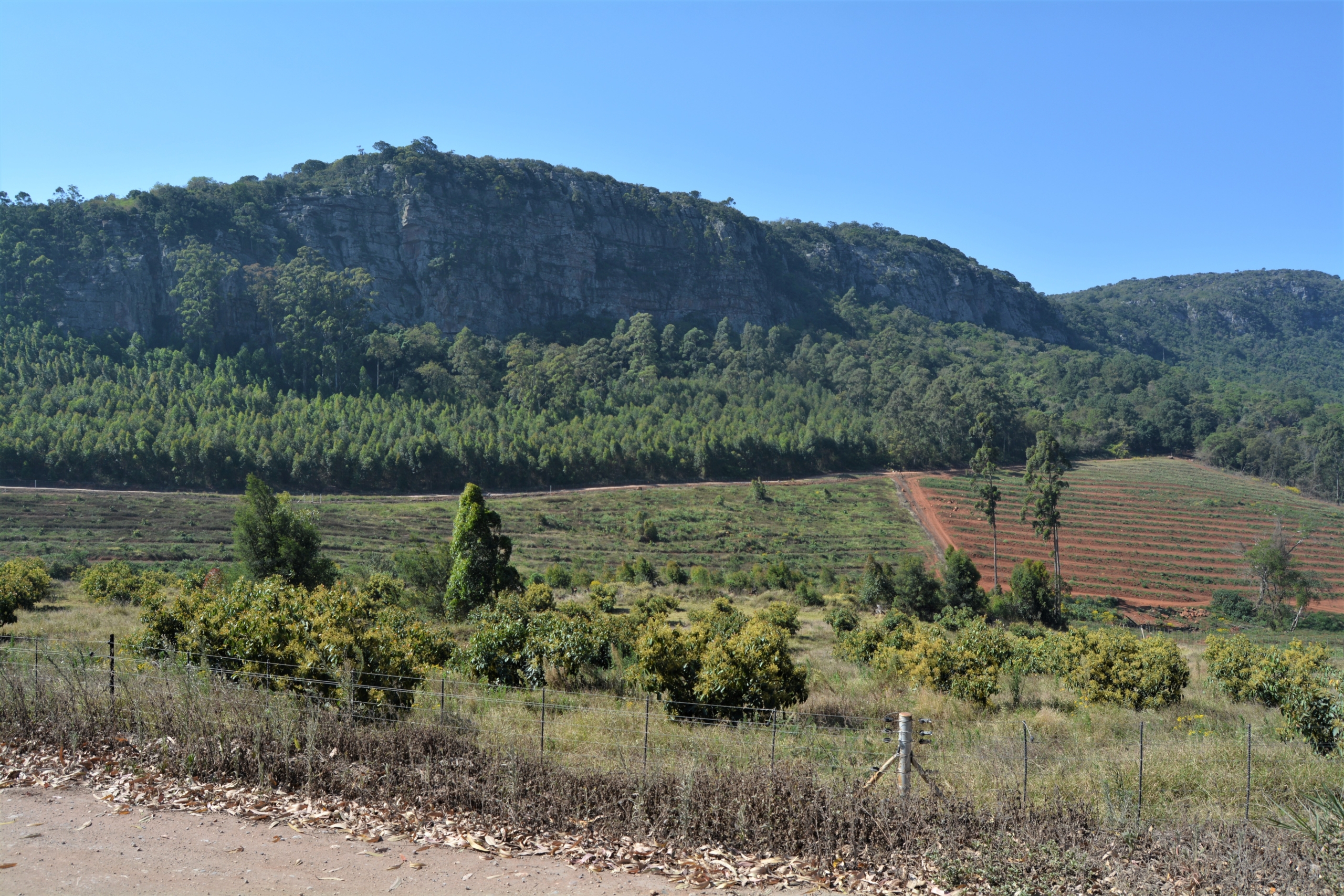
Some parts of the farm are inarable, some is planted to timber, the less steep portions are under avocados, guavas and macadamias.
In 2000 this area experienced intensive floods and many of the avo trees, in the valleys particularly, died. As JAFF does not believe in planting an avo tree where one has already died, he filled these gaps with macadamias and guavas. And so JAFF’s cross-crop expertise grew, his new developments are largely macs and he is now an avo, guava and mac farmer. He has extensive knowledge of these crops right from nursery to retail and has ridden the tumultuous waves of agricultural prosperity and despair having seen 3 mac crashes in his career; the last one was in 2008, when he was heading up the mac processing company; the mac price went from R12,50/kg kernel to R4,50/kg kernel for the smaller styles ‘overnight’ AND the rand strengthened simultaneously. The stress of that week alone was enough to spur JAFF on to the next chapter.
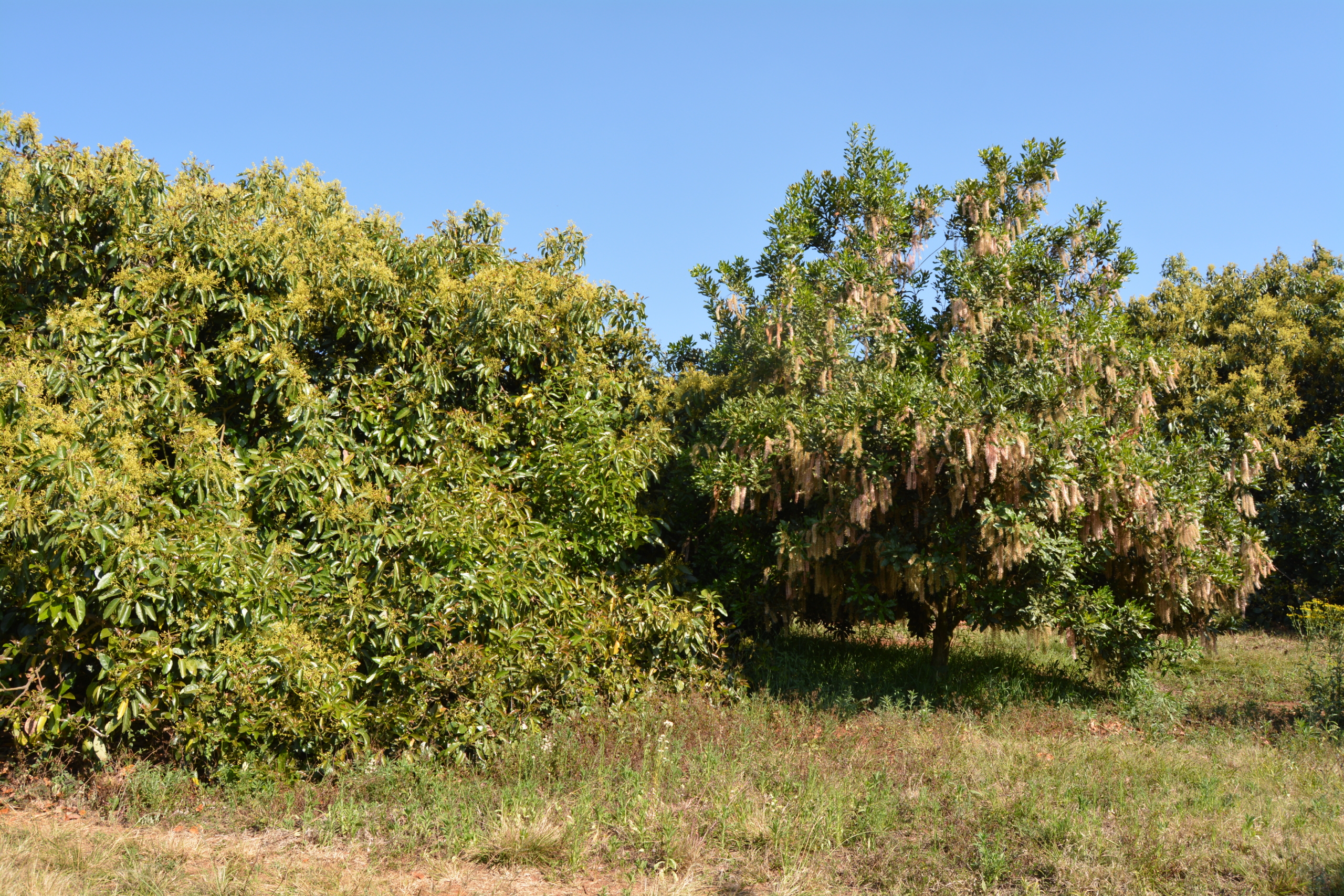
Avos and macs living side by side.
But it seemed that stress followed him as the consulting he did, with the land claimants, also reached an end. After 8 years it was time to move on and, currently, he is supporting the landowners in looking for investors to lease those farms as the community lacks the capital to carry on. For 3 years now there has been a 50%+ decline in crop; a trend that is not unique to the land claimants but plagues most mac farmers in Levubu. JAFF believes the Levubu valley is just getting too hot for macs and the trees too old and tall for effective spraying.
On the upside, there seems to be an interest in guavas again despite the ongoing challenge of ‘Malelane wilt’, a disease for which the scientists are yet to find a resolve. But JAFF says that clean orchards can last 8 to 9 years, the yields are good in that area, and the demand for guava juice is picking up. When (apparently it’s more of a ‘when’ than an ‘if’) the crop does succumb to the wilt, the crop has to be rotated; bananas, or something similar, is an option.
MARKETS
I was eager to hear the insights of an accomplished businessmanXfarmer such as JAFF and soaked up all he had to share on markets … “Let’s look at the avo market today,” says JAFF as he pulls out his phone, “on the Cape Town market there are 18 000 trays, which is back to normal figures, as opposed to a month ago when there were 74 000 trays and reports of someone dumping ripe fruit in the car park at the Pretoria market.” JAFF goes on to explain how the sudden market crash is playing out in his context (remember, I was there in Sept 2022); “The farms in the Levubu valley start picking Fuerte in February. Prices were nice and high at around R200/tray. Everyone jumped into the market. Then Russia invaded the Ukraine. Shipments bound for their shores had to make u-turns. The loads were diverted to Europe which then became flooded.”
Continuing on through the painful recollection JAFF explains how South African ports were in a disastrous state at the same time which meant that local markets became over-supplied and also crashed. Some farmers were only getting R10 to R15/tray (back on farm) which is a devastating loss. The trouble with avos is that they are perishable. Thankfully they can be ‘hung’ on the trees, without ripening, but that is obviously not an indefinite solution. So, everyone was hanging fruit and quickly harvesting as soon as there was the slightest upward movement in prices … the subsequent over-supply then resulted in another price drop. The longer fruit was hung, the higher the risk of it ripening too fast and being rejected (which is why the dump happened in the Pretoria carpark). Any hope of profitability in this market was smothered. The lid was just about nailed down on the coffin of the 2022 avo farming season.
The cooler weather on JAFF’s farm is a blessing in that it allows him to wait later in the season than most. He usually starts harvesting in August but delayed it this year while watching the markets. He also had to keep one eye on next season as a late hanging crop can stress trees and result in poor productivity the following season. He will have to invest in feeding the trees up to get through this tumultuous time with enough energy to start again.
INDUSTRY CHALLENGES
Besides deranged despots invading neighbouring countries the avo industry faces many other challenges. The biggest of which, in JAFFs view, is logistics (transport) because of the poor state of our ports and the shortage of containers post-covid shutdowns.
The cost of fertilisers also increased by over 300% recently, largely due to the Russia-Ukraine war. And other chemical costs have also sky-rocketed. Fuel and packaging material costs have also gone through the roof.
Climatically, increasing heat is pushing back on a lot of marginal avo-growing areas.
And then there’s the socio-economic challenges of our region which plays out in uncontained theft and an influx of foreign nationals desperate for work.
By this stage, I was ready for an early drink! And was eager to bury my head in the sand and see what gems we could find there …
DIVERSIFICATION
There are still so many things to be grateful for; JAFF’s education and journey had certainly set him up well for diversified interests and this has ensured his continued prosperity despite mac and avo catastrophes. He has a degree in Agricultural Economics with additional horticulture subjects.
After varsity, he spent a year on a Kibbutz in Israel. He laughs that he never really left the kibbutz ethos behind as he still has an incredibly diversified portfolio and all the family is involved!
Besides commercial property and the industrial businesses already mentioned, JAFF also employs vertical integration by running a mac and guava nursery and a fruit canning facility.
There is also lots of timber on the farm which will gradually make way for fruit trees. The good 2019 season allowed him, during COVID lock down, to bring in an excavator and remove 70 ha of bluegum. The beautiful soils under these trees will be used for either mac or avo as JAFF expands.
AVO CULTIVARS
JAFF has always focussed on Fuerte because he doesn’t export. He says it doesn’t make sense to export at the time of the year his avos are ready which is also when the northern hemisphere crop is coming on to the market. So, he chose instead to grow what South Africans love and that’s Fuerte. Again, out comes JAFF’s phone so we can see today’s prices on the local market:
Fuerte (size: 10) – R110 to R120 per box
Pinkerton (size: 10) – R70 to R80 per box
Hass (size: 10) – R60 to R70 per box
Of course bigger farmers have greater volumes and therefore need to export. Export markets prefer Hass avos and therein lies a fundamental guide for choosing which cultivar to grow; Export = Hass. Local = green skins.
A challenge in growing green skins is their susceptibility to Cercospora/Black Spot. JAFF has been advised that Maluma Hass cope better against this fungus but, so far, they’re struggling on his mountain top as they’re more susceptible to cold damage. JAFF does concede that the batch he planted were not of the best quality. And so he will not rule Maluma out based on this batch.
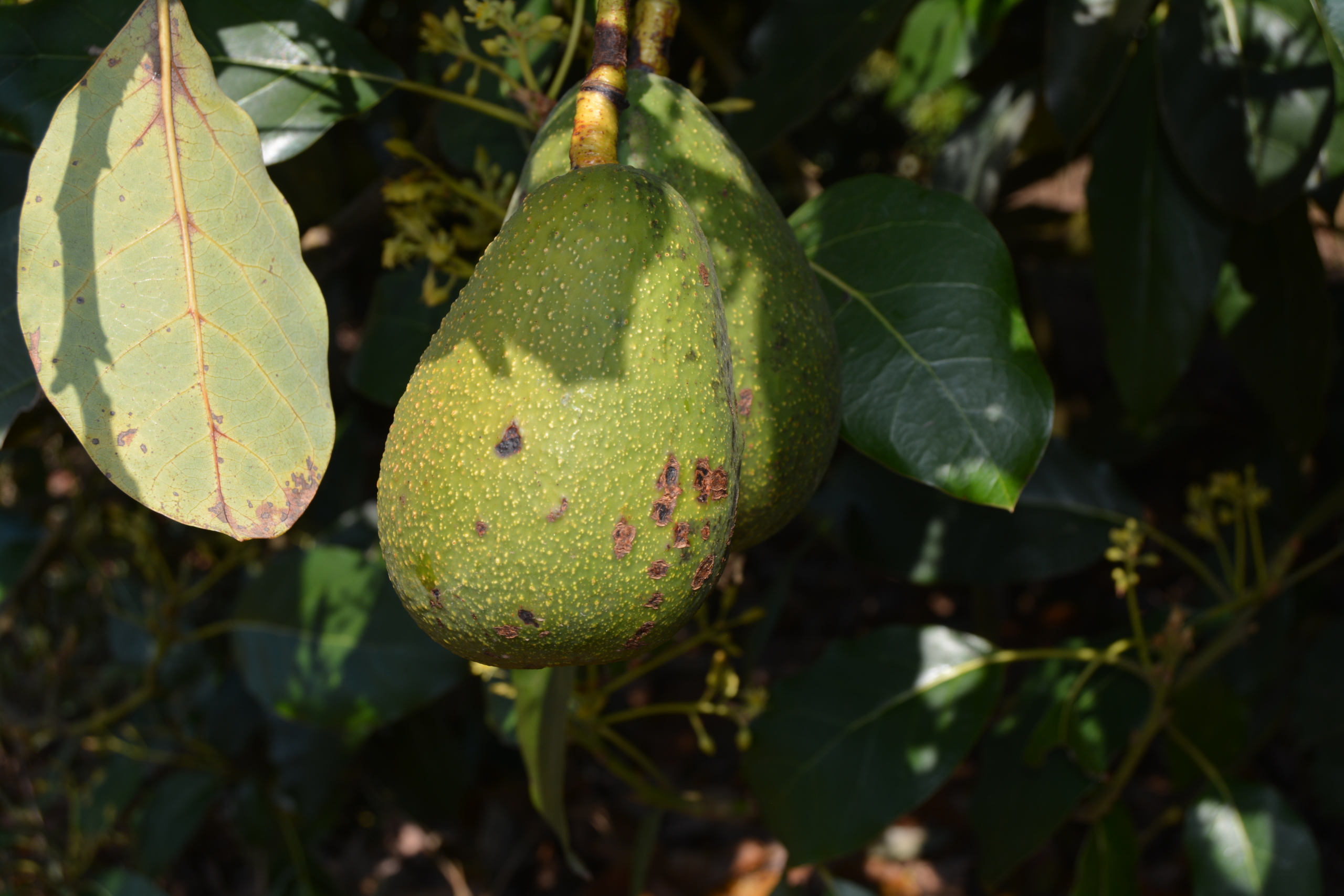
Cercospora – typical of Fuerte avos. These avos will end up as third grade.
To treat the black spot, JAFF uses a systemic fungicide as a first spray and also sprays with copper every 30 days. They use handguns so that the individual fruit can be directly targeted.
As with most mountains (think about Table Mountain’s tablecloth) there is a lot of mist. JAFF says that he’s noticed how the trees make excellent use of this moisture as it precipitates in the trees. After mist it will be wet under the trees whereas the road will be dry. JAFF would like to get a mist gauge (like a rain gauge – is there such a thing?) to verify his guess on the significant amount of water caught.
Although the mountain doesn’t get white frost, black frost, in the icy wind, is a real killer. Despite this, the Fuertes have always been fine, provided they’re planted in the right micro-climates. They don’t plant anything in the valleys as that is where the black frost lurks.
Surprisingly, hail is not an issue and has only occurred about 3 times in the last 40 years.
NURSERY
JAFF’s nursery was a fascinating place full of new ideas and alternate practices. Although JAFF is well aware of current trends and developments, he also tests everything and applies that to unique conditions.
His old (65 years+) avo trees are all on seedling root stock and JAFF says “they’re perfectly good”. He does inject them for phytophthora every year. The sight of this practice alone makes me shudder so I asked a bit more … “I’ve been doing it for 30 years and it’s not an issue” he confirmed, “the phosphoric acid goes up into the leaves; forms into phercetile aluminium; which then goes back down through phloem to the roots.”
JAFF asked me to verify this and, while I failed to do that, I did discover two other very interesting things about phosphorous injections, thanks to https://www.chemjet.co.uk/
- Efficient and cost-effective use of phosphonate fungicides is based on understanding and working with the phenology or growth phases of the tree When potassium phosphonate is applied to trees it enters the tissues and becomes completely systemic moving within the vascular system to all parts of the tree. However, the quantity found in various organs will depend on the stage of growth at the time of application. This is due to different parts of the tree having stronger or weaker access to resources. For example, small, fast-growing fruit has the highest priority for available nutrients, shoots and leaves the second highest while roots have the lowest priority. If young fruit are developing on the tree at the time of treatment most phosphonate applied will move to these fruit with very little reaching the roots. Since we are controlling a root disease, the fungicide needs to be applied when the tree is directing most of its resources to the roots.
- It should also be remembered that even though phosphorous acid is systemic, moving from roots and leaves to other organs, it does NOT move laterally around the tree. This should be remembered when injecting. Many growers are now using concentrated product to reduce the number of injection points. This is truly a false economy as you are overdosing a small area of roots and leaving large areas of roots untreated. Always distribute the injection sites evenly around the tree.
JAFF produces macs in the nursery but, since that industry has quietened down he has turned his attention to the increasing demand for guavas.
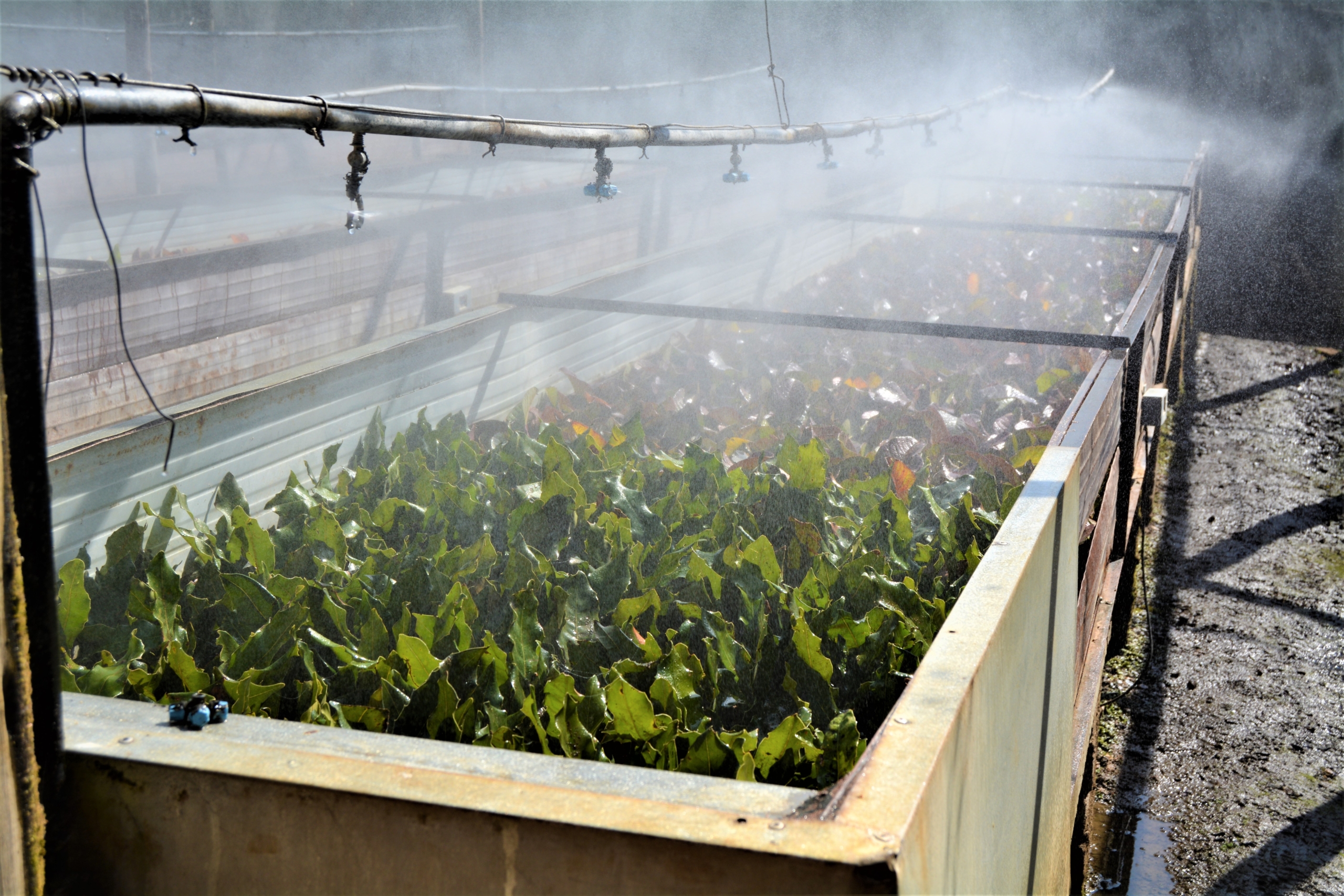
Macadamia nursery – these are Beaumont cuttings which JAFF uses as a root stock (so it is a clonal root stock). The misters spray for 10 secs every 3 to 4 minutes which keeps the atmospheric moisture high, leaves respirating and, with the sunlight, they continue to photosynthesise. This energy stimulates healthy roots. The spray is currently working on a timer but will be upgraded to take humidity, leaf and soil moisture into account and activate only when levels require the moisture. The beds are warmed by pipes, carrying hot water. These are heated by 4 solar geysers, maintaining a temperature of about 30°C.
The Beaumont cuttings in the mist bed above may or may not be grafted with another cultivar. JAFF is no longer encouraging farmers to plant Beaumont because of their poor crack out and style. Since mac markets and demand has changed, this predominantly Style 4 (halves) cultivar is far less profitable.
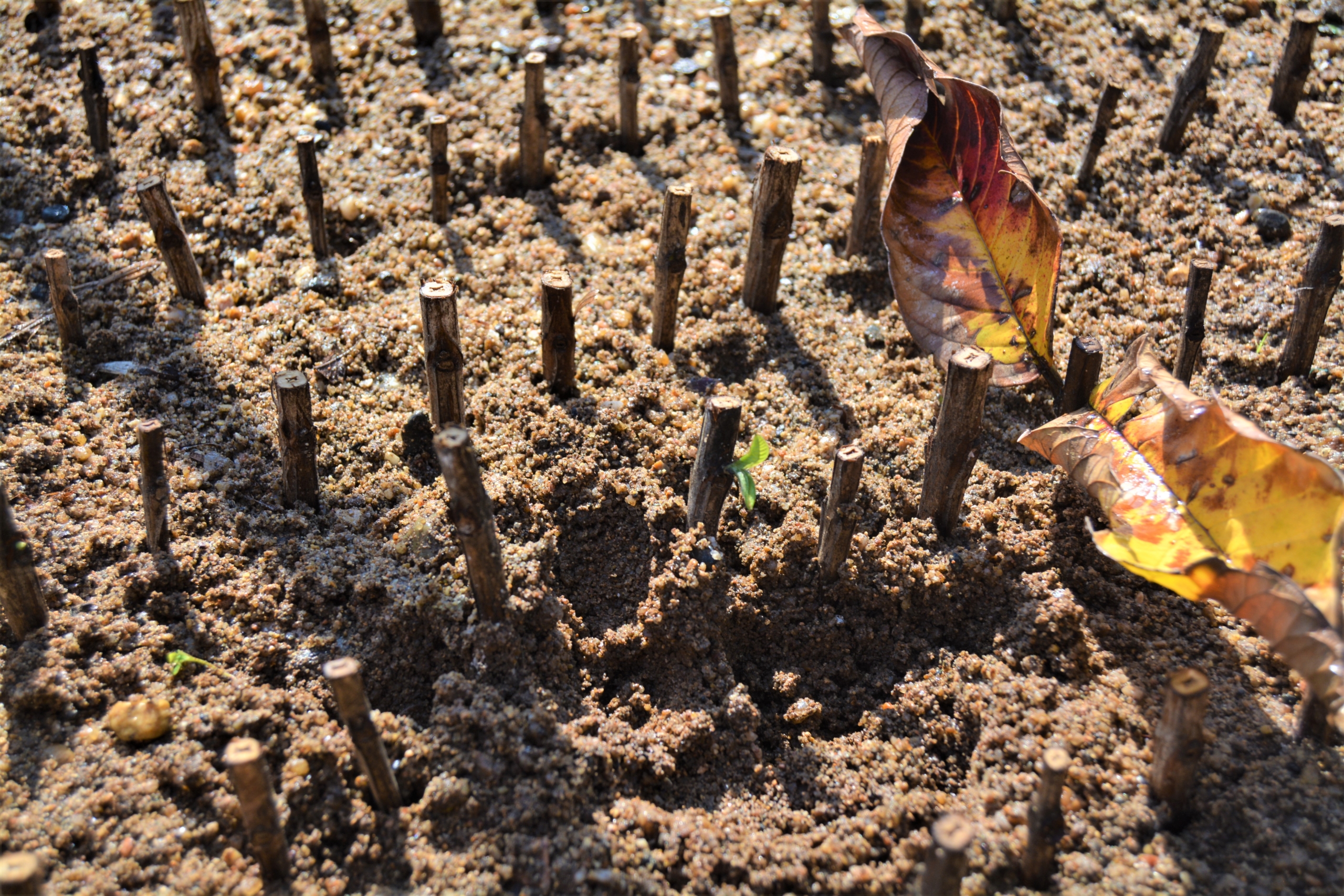
Guava cuttings: Jaff likes using pine bark but his son prefers sand. Guess who planted these! The nurseryman has also experimented with mediums when he ran out of pine bark and decided to use compost; it was too strong and burnt the trees.
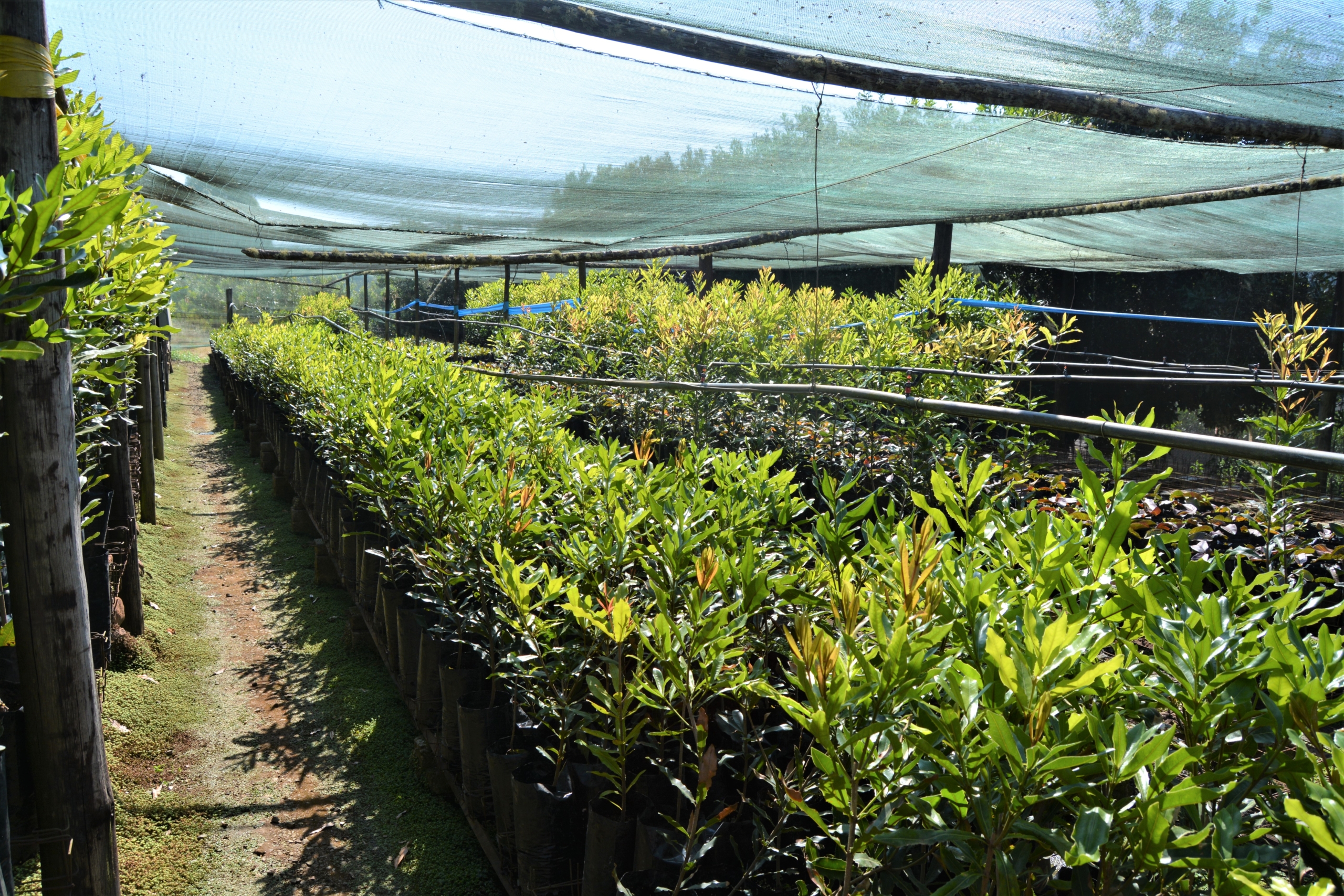
Building up stock for his new macadamia orchards
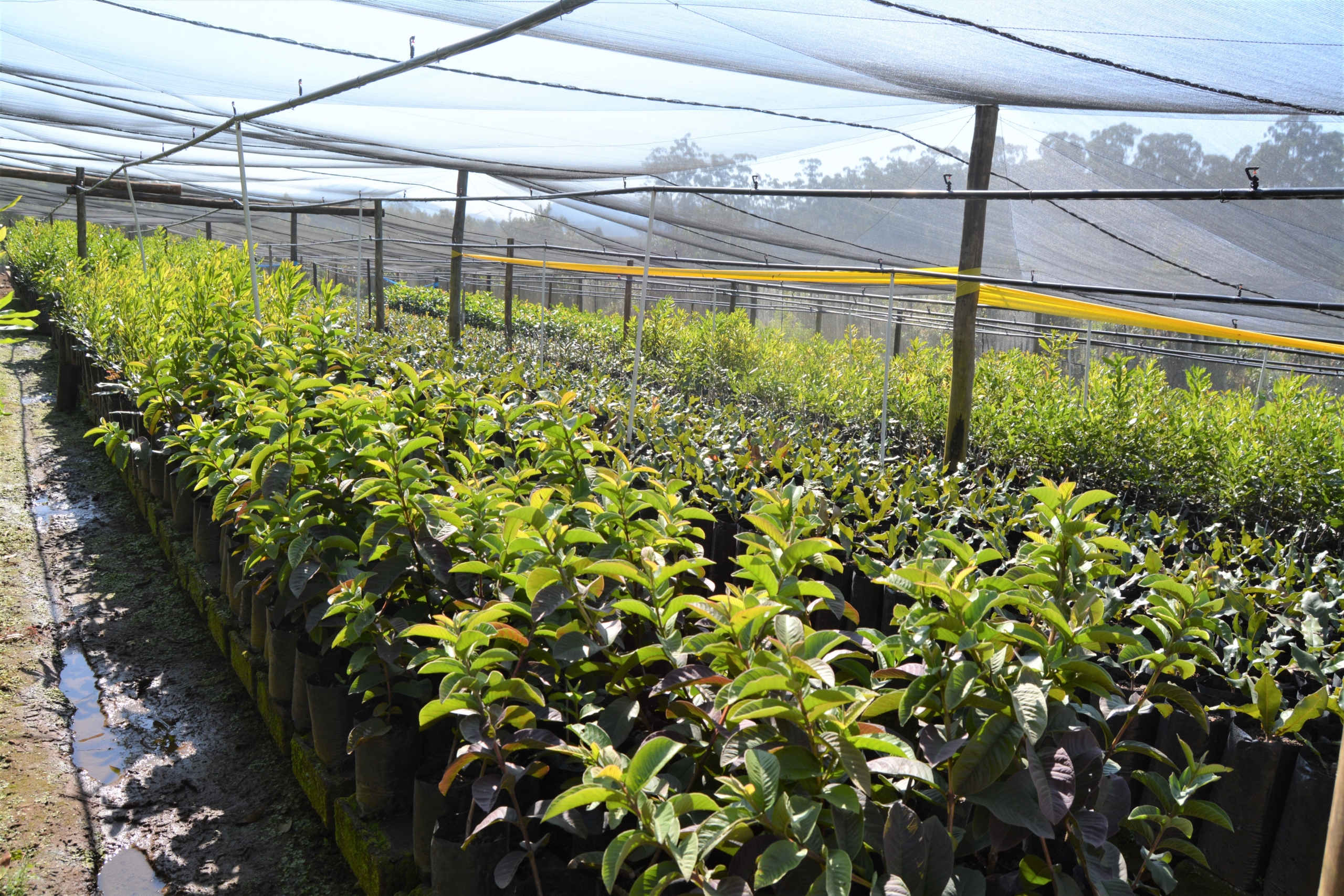
Guavas
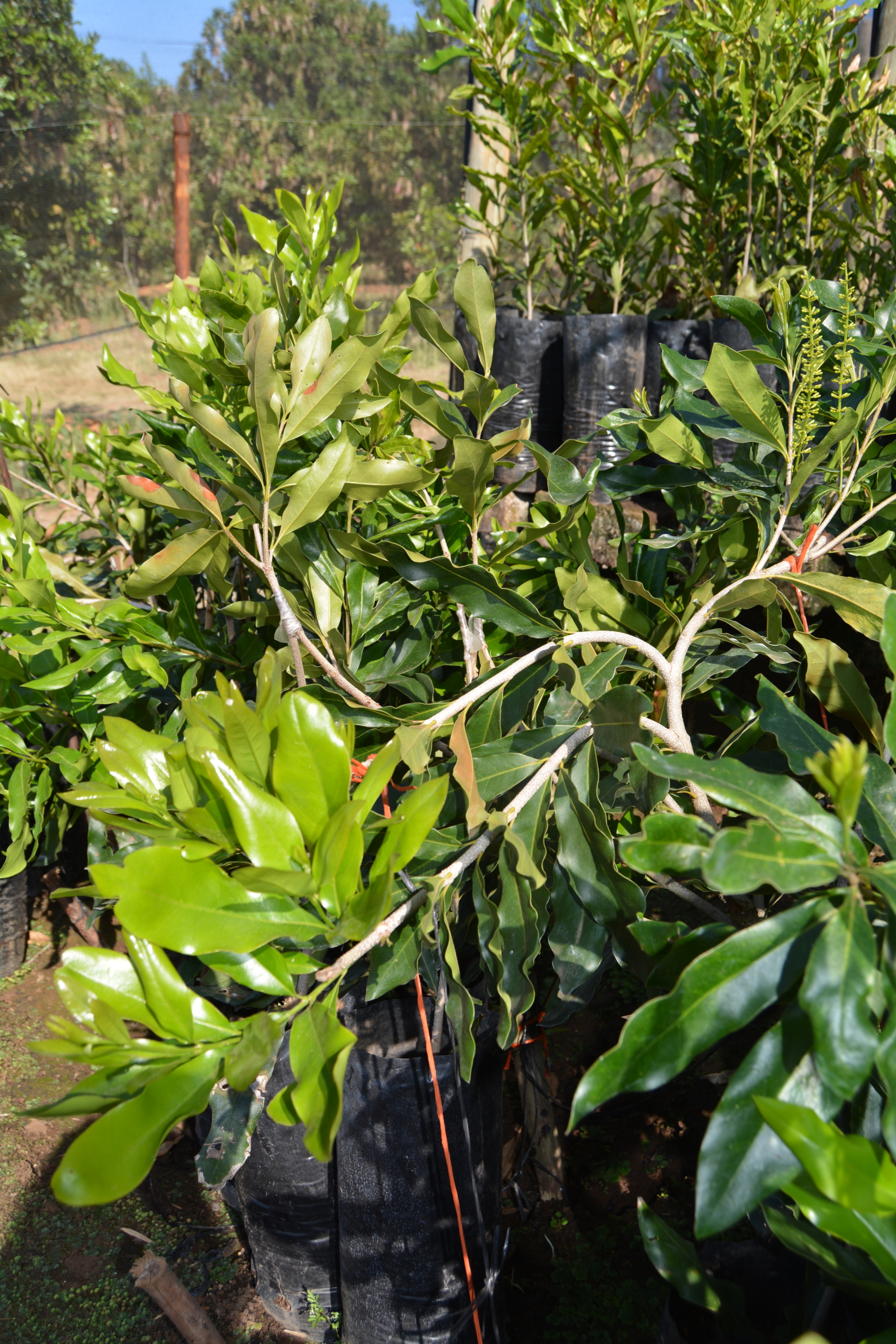
Another fascinating activity in the orchard but I’ll keep it brief as this is an avo story and the activity involved macs … Approach grafting, which JAFF says is very quick and very successful. The scion is taken from a grafted 791 (Fiji) which is planted in the ground, inside the nursery – JAFF has a whole row. Small branches from these ‘motherwood trees’ are staked down. When they naturally start shooting upwards again and form a nice ‘wave’ to meet the height of the root stock tree, they’re ready to join to the root stock. This part takes a few weeks. They then slice a nick out of the scion and out of the root stock and tape them together. About a month later they will nick the branch (before the graft) coming from the scion side so that the grafted material starts using more energy from the root stock side. A few weeks later, it’s nicked again, a bit deeper. It takes 3 gradual cuts like this to force the scion wood to draw all its energy from the root stock and be ready for complete severance. JAFF says it’s a maximum of 2 months and you have a successfully grafted tree.
We did an illustrated, more detailed, piece on this in the 11th edition of QUIPS.
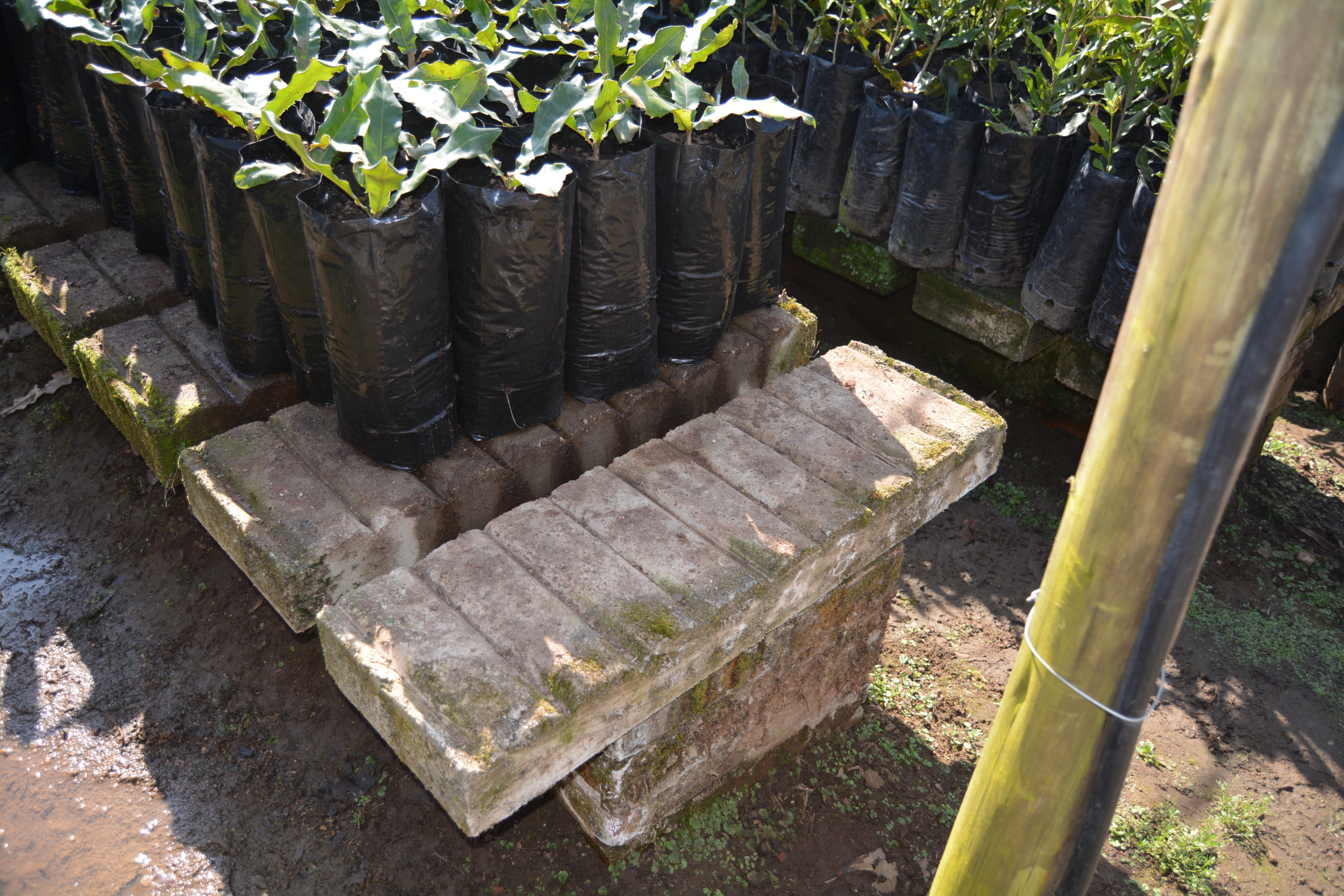
I really liked these special nursery blocks that facilitate good drainage from under the bags and helped keep the nursery nice and neat.
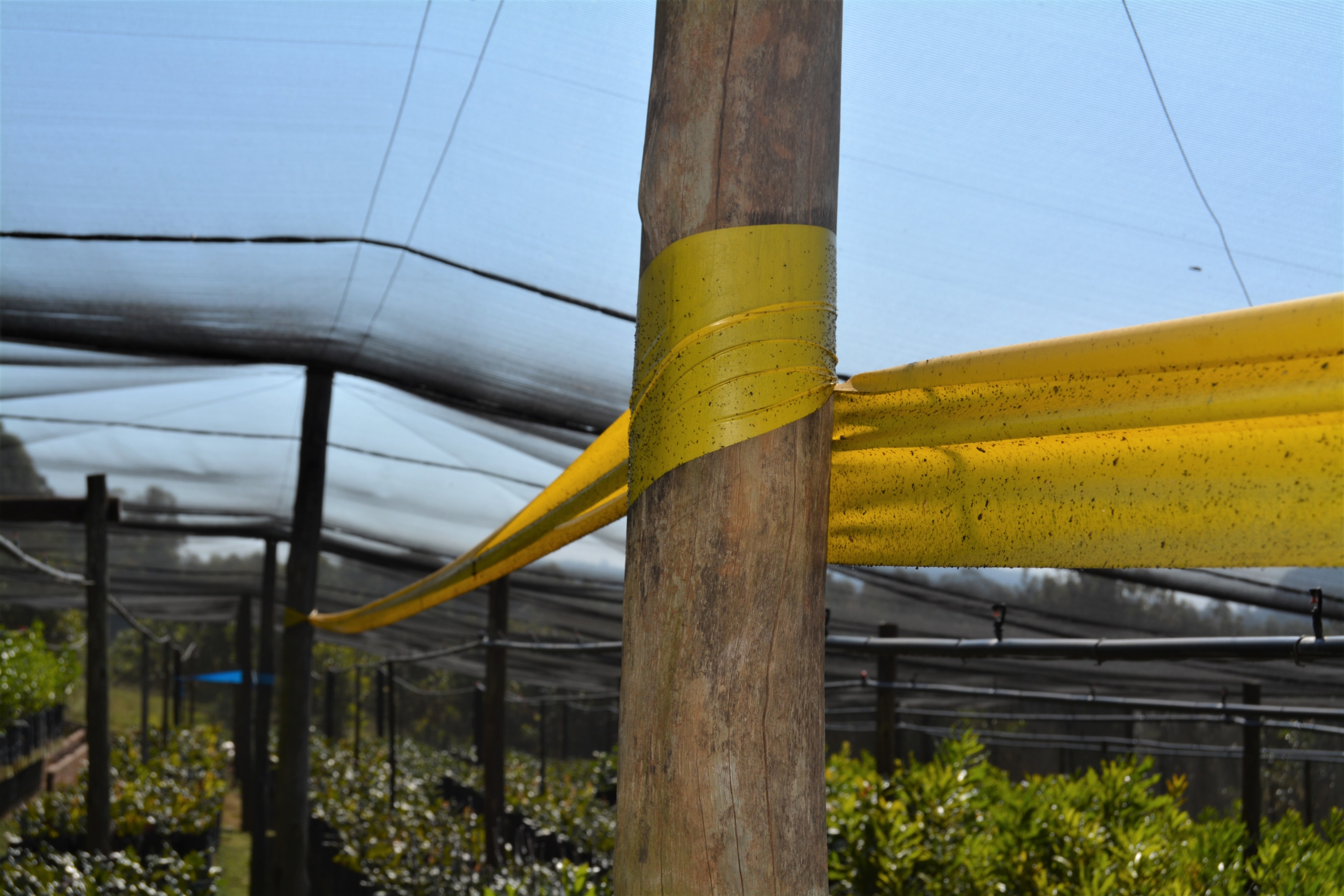
This thrips tape was also highly effective and cut out the need to spray.
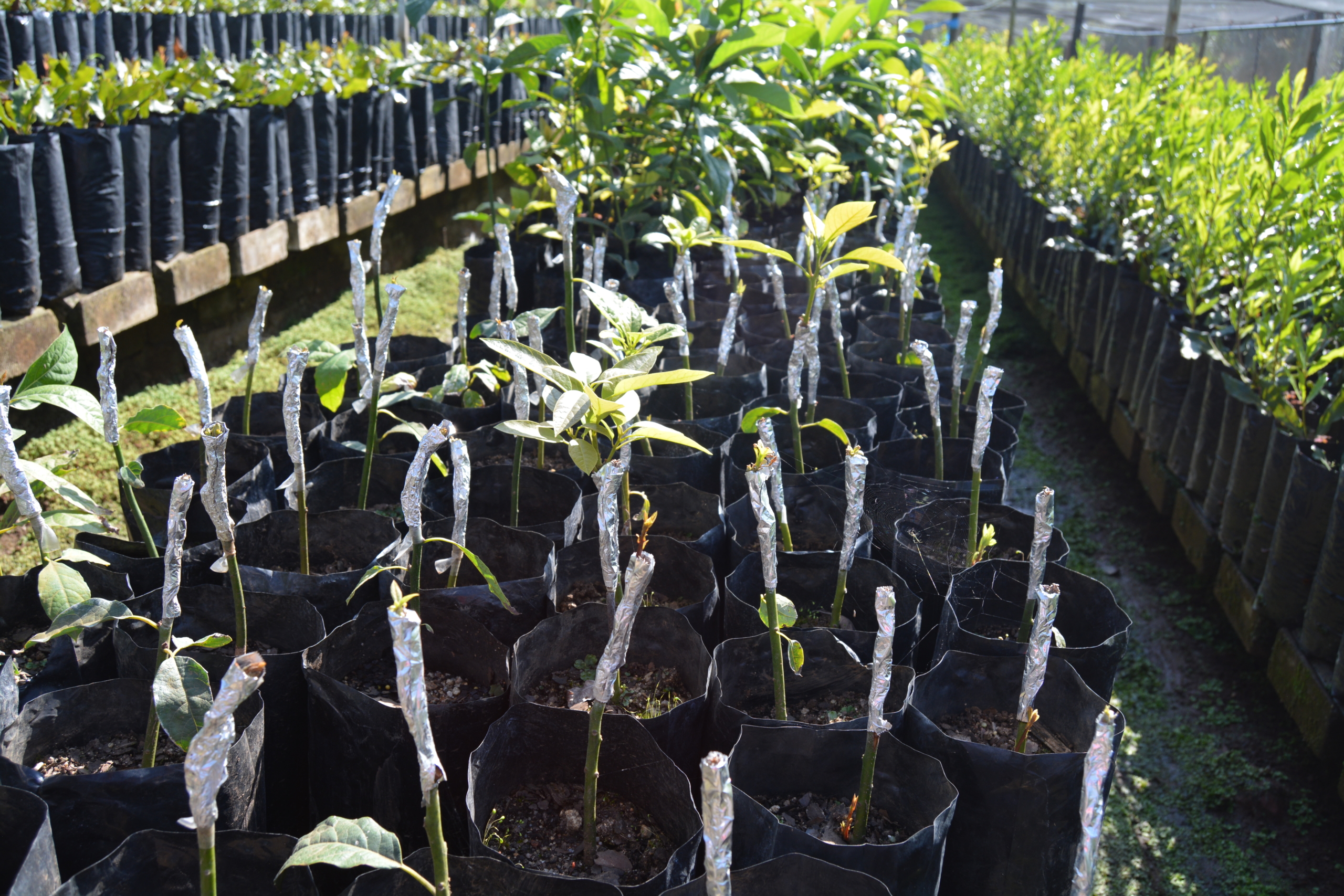
Fuerte budwood on Edranol seedling root stock. Grafting tape and then tin foil over that.
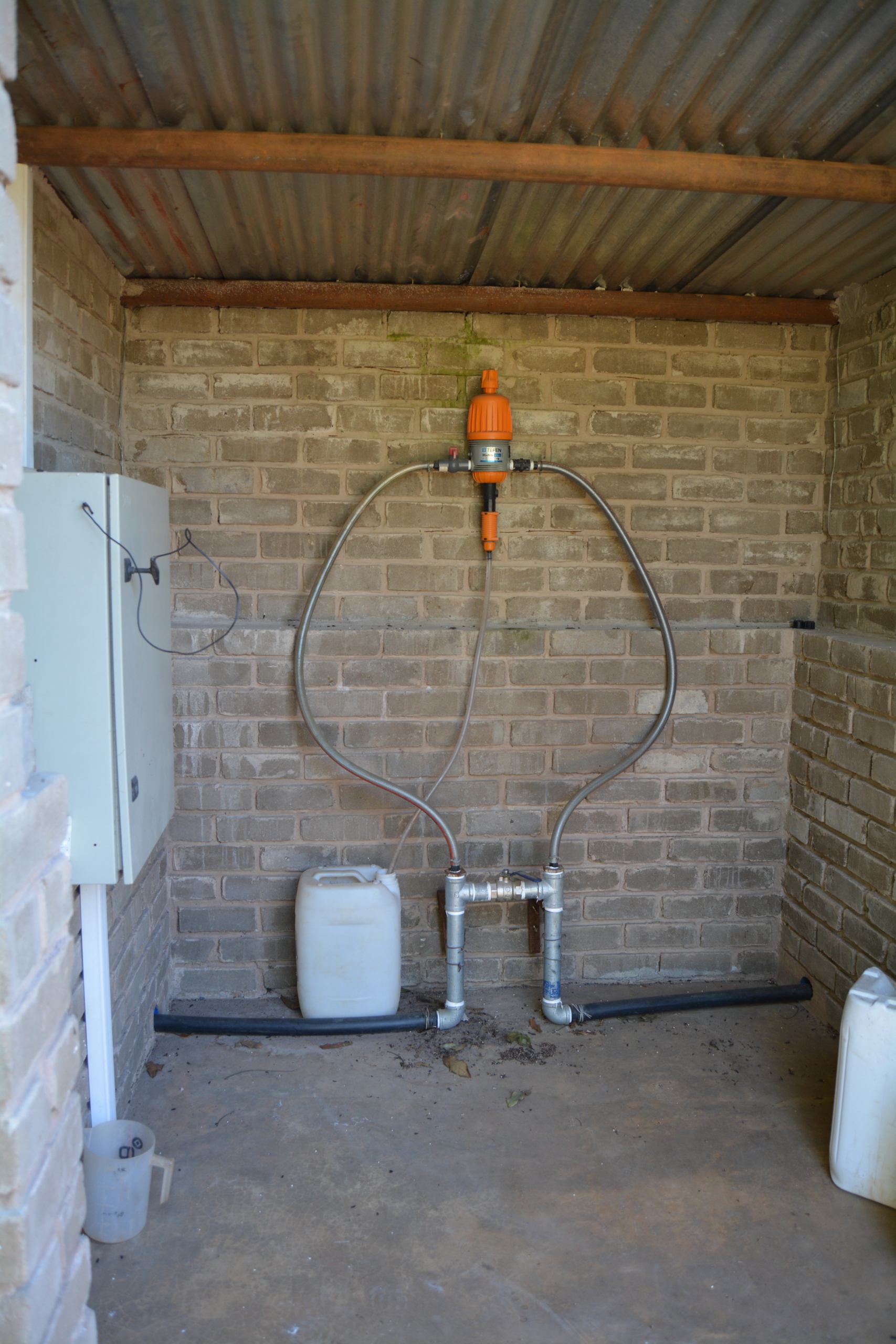
Every week something different is added to the water irrigating the nursery; magnesium sulphate, ammonium sulphate, and a general mix of all nutrients in one product. It is applied as a 1% mix.
PLANTING AND LAND PREP
JAFF believes in testing extensively BEFORE you decide what to plant. A premature decision on what you want to grow might be the downfall of your farming; rather test the soil and see what will do well there. Be prepared to pivot if the recommendations are different to what you’d planned.
When it comes to soil prep, JAFF advises that you lime in both dolomitic (supplies magnesium) and calcitic (supplies calcium) forms and get that lime in properly and down deep. He’s just applied 1,5 tonnes per hectare of each to his new establishments. He rips, cross rips and discs the soil in new fields. In one of the latest developments, soil scientists told JAFF that his soils are up to 2,5m deep so he asked about whether ridges are necessary. They said no, they’re not. But, when he had some farmers visit, they convinced him to plant half the development on ridges so that they could see the comparison – so that’s what JAFF did! Pity we have to wait a few years for the results.
The ridges were made with a bulldozer, about 1m tall, flat on the top.
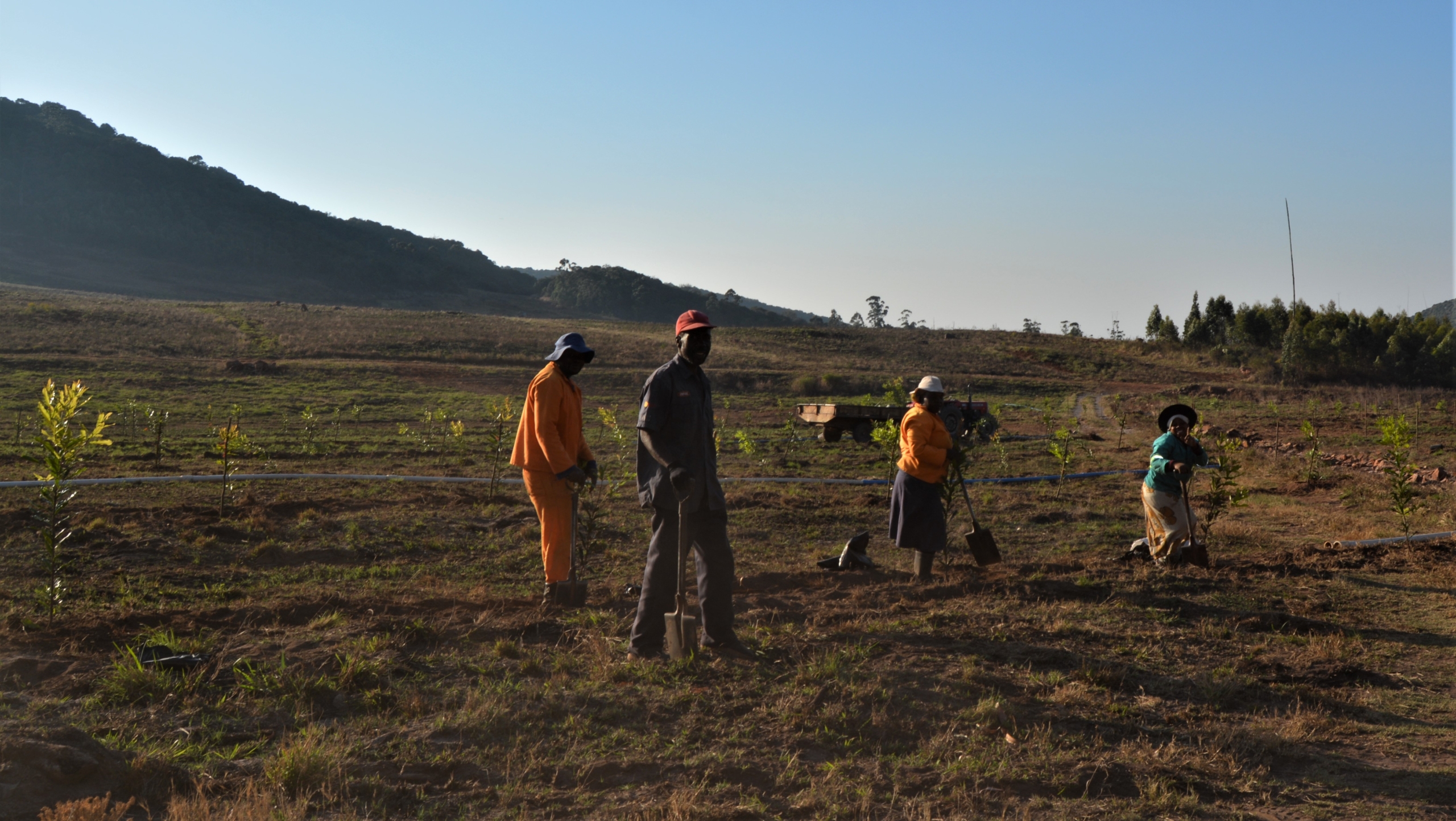
New mac developments – non-ridged.
When it came to planting, JAFF mentioned all the ordinary ‘rules’ like keeping the soil level consistent between the bag and the new bed but he did mention one I hadn’t heard before; place your blade (to cut bag open) on the inside (of the bag) so that it doesn’t cut roots as you slice open the plastic – a bit challenging with a full bag but the context of not damaging roots is sound.
JAFF applies a slow-release, general feed, charcoal fertiliser at a rate of 1kg in every hole when planting and he drenches with a bucket/tractor in the first few months because the roots are not ‘in the soil’ yet so you have to make sure that the ‘bag’ area is getting water.
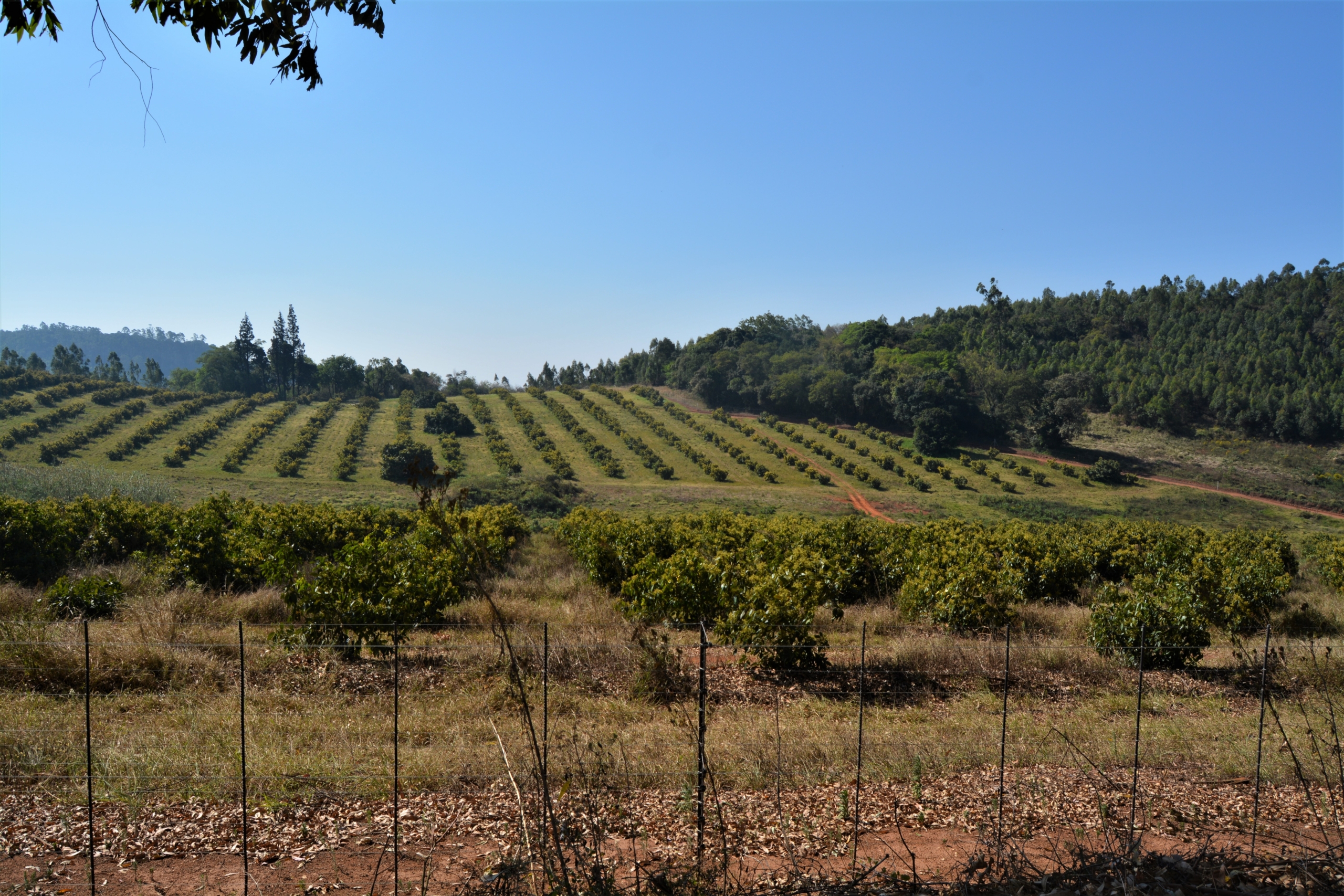
Young avo orchards
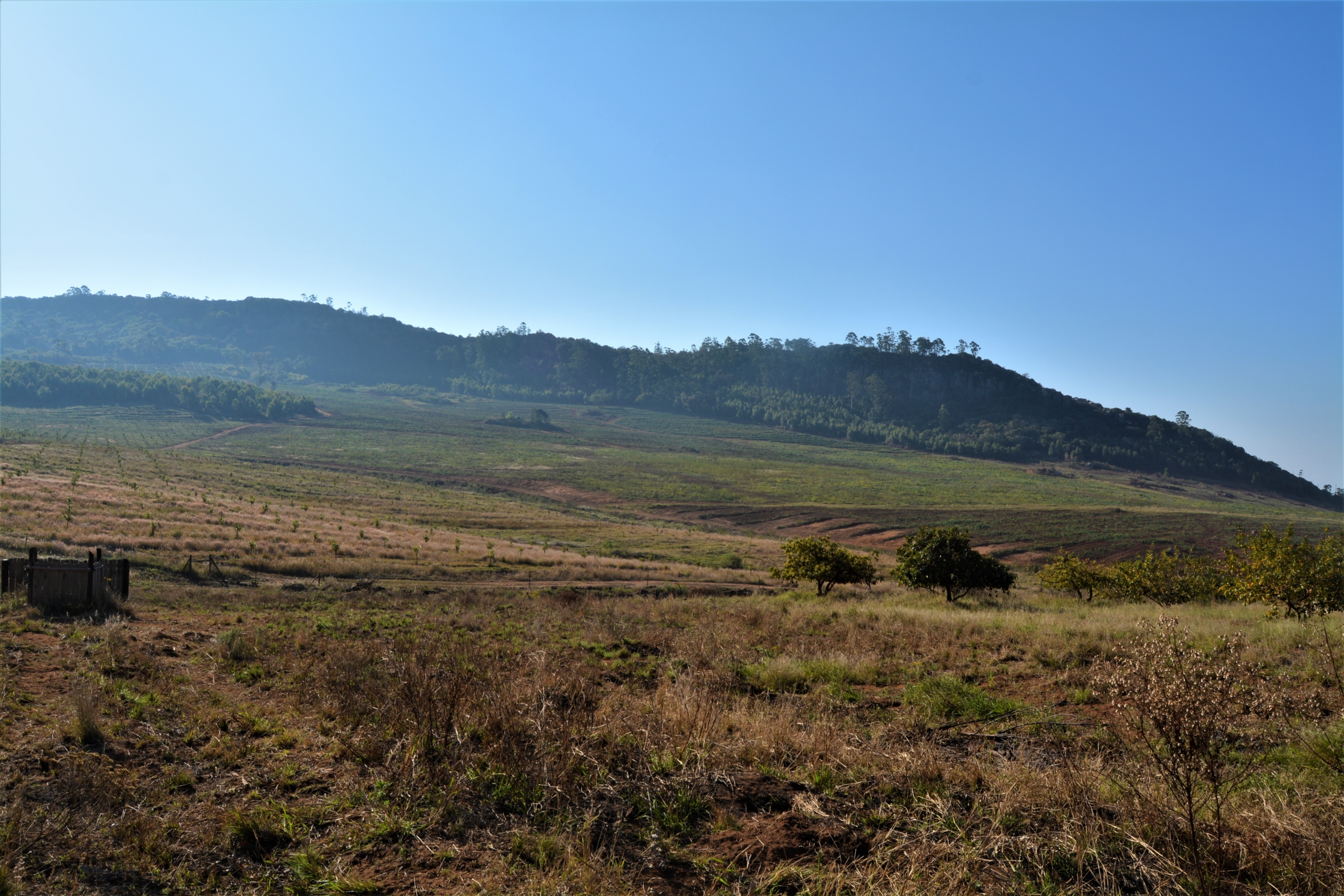
New developments of macs in the sandy soils and avos in the better soils, some on ridges, some not. This was all blue gum plantations. When they removed the gums, vleis formed – some actually flowing. JAFF keeps all orchards well away from the waterways. Some gums still near the top – land there is just too rocky to cultivate.
INTERROWS
JAFF is going to be using hemp in the interrows because it grows tall and will therefore help in breaking the wind buffeting the young trees. It also has a high fibre content and therefore makes great organic matter. I laughed that his worker productivity was going to plummet because the workers might decide to smoke the ‘wind breaks’ … but I soon found out how little I know about ‘weed’ … in case there are any other ignoramuses out there; hemp is different from cannabis. The hemp JAFF is planting lacks the bud which is what is required to achieve the high. How did I not know this? Apparently hemp and cannabis are related but not the same.
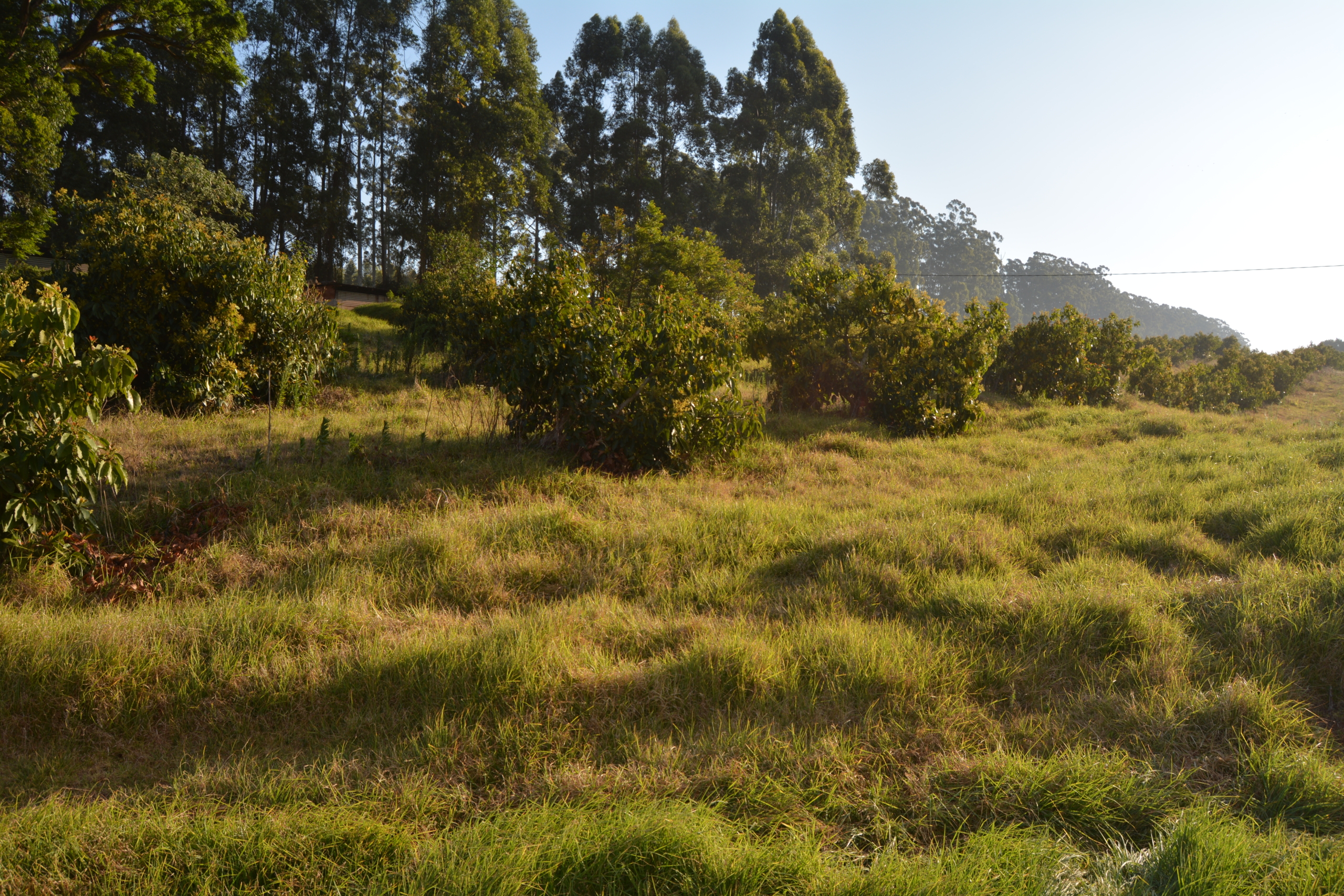
Kukuyu grass throughout this orchard – JAFF likes it because it creates a nice mulch when slashed and stops other “weeds” growing. It will also be a good feed if JAFF brings cattle into the orchards to add fresh “kraal manure” to the soil.
He’s also planting a mix of 7 different grasses and legumes as a cover crop.
JAFF has tried to use the interrow to generate an income and did plant gooseberries when the avos were small. He found them very labour intensive and, now that labour rates have gone up so much, he says it might not be worth it.
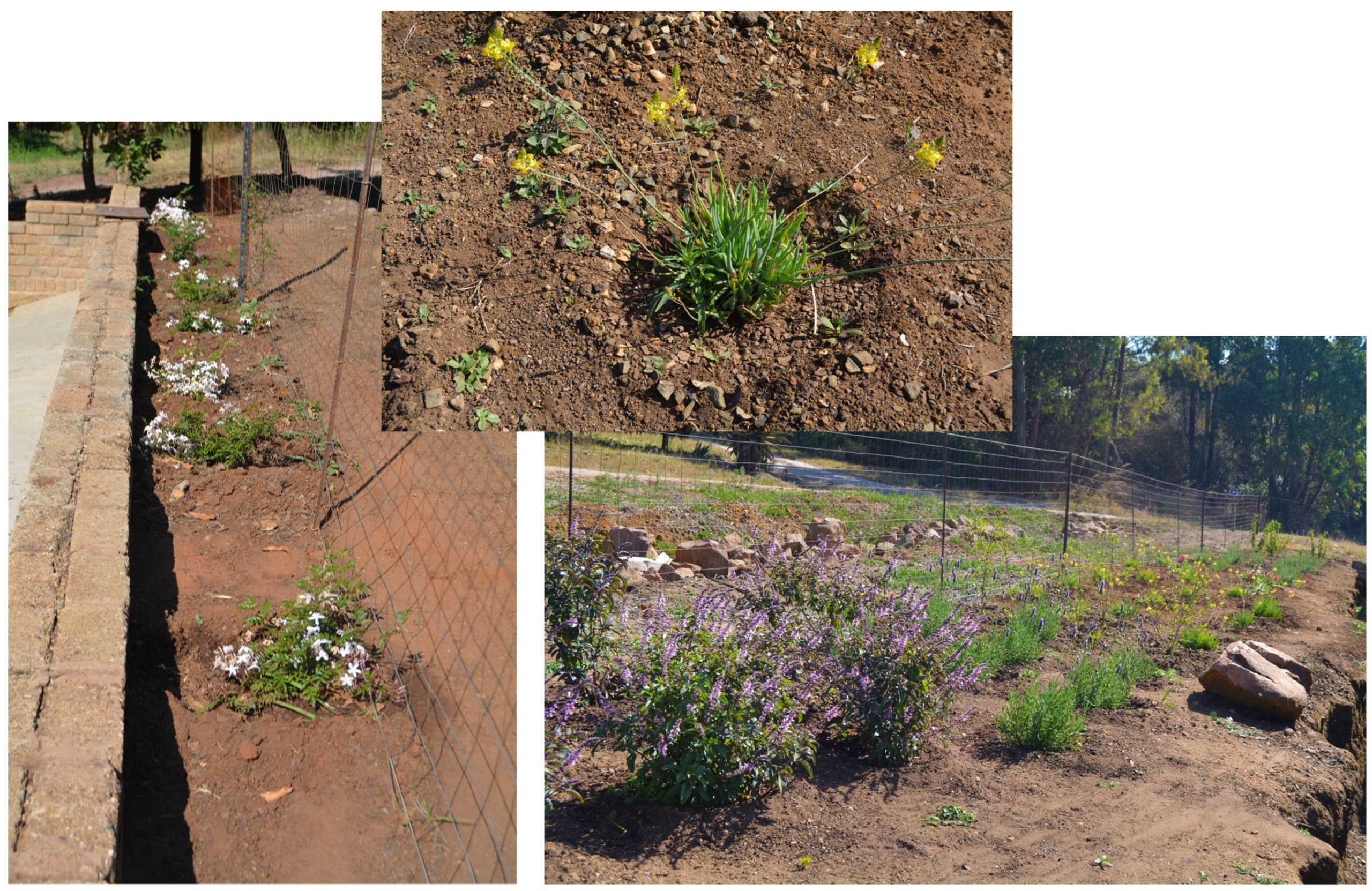
Diversity in interrows: Left is jasmine, Centre, with yellow flowers, is bilbine; a succulent that’s juice is a great healer of skin ailments. On the right is an indigenous lavender, basil and more bilbine.
SPACING
20 years ago JAFF was planting at 6m x 5m. These trees were on a Duke 7 root stock and he’s found them way too vegetative for this density. He has also cut back on nitrogen to these orchards by switching from 3:1:5 to potassium sulphate with a side serving of phosphate. In so doing reducing the N applied. The set is now much better.
JAFF now plants at 7m x 9m in both ridged and non-ridged orchards. He is now purposely planting more sparsely so that cover crops get light and soil health (hopefully) improves.
The OGs (65 year+) avos are planted at 10mx 10m and, despite the sparsity JAFF is struggling to keep the ‘windows’ in these orchards open. He has had to employ a new pruning strategy that entails a permanent team clearing out the “mambas” (vertical, unproductive growth that blocks sunlight).
PEST MANAGEMENT
JAFF’s practice of interplanting avos macs and guavas raises a few eyebrows, especially from those who struggle with pest management when farming these crops together. But JAFF has not experienced the same challenges; “We’re at 1400m up here and a good 10°C+ cooler than the Levubu valley,” explains JAFF, “consequently the insect complex is very different and not a problem.” So far he hasn’t had a problem with thrips. The harvest season up here is also much later; it was mid-September when I was there and they hadn’t started picking avos yet.
JAFF believes over-spraying could be a detrimental factor in the Levubu farmers plight with pest control.
Of course, the extensive natural area on the mountain introduces a range of “teeth” to threaten JAFF’s crops; most of which are mammalian, and the worst of those is baboons. Last year his young (unfenced) mac crop went from 17 tonnes to 1 tonne! Not only do they take the fruit, they also break the trees. He’s since installed some electric fencing which has helped this year but it’s expensive to maintain.
Since the incidence of human theft continues to increase he has also installed security cameras. (Like farmers don’t have enough on their plates! )
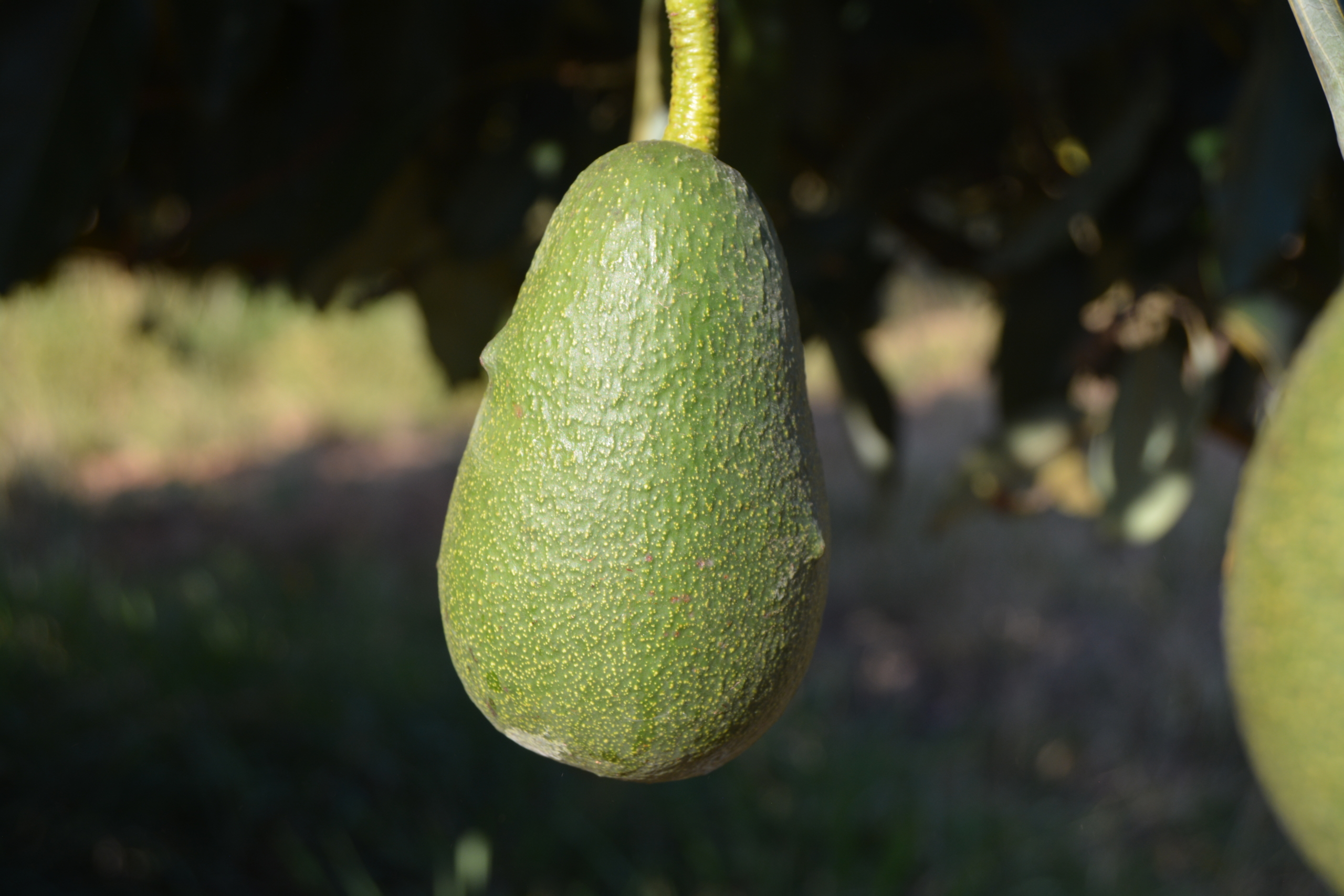
Insect stings.
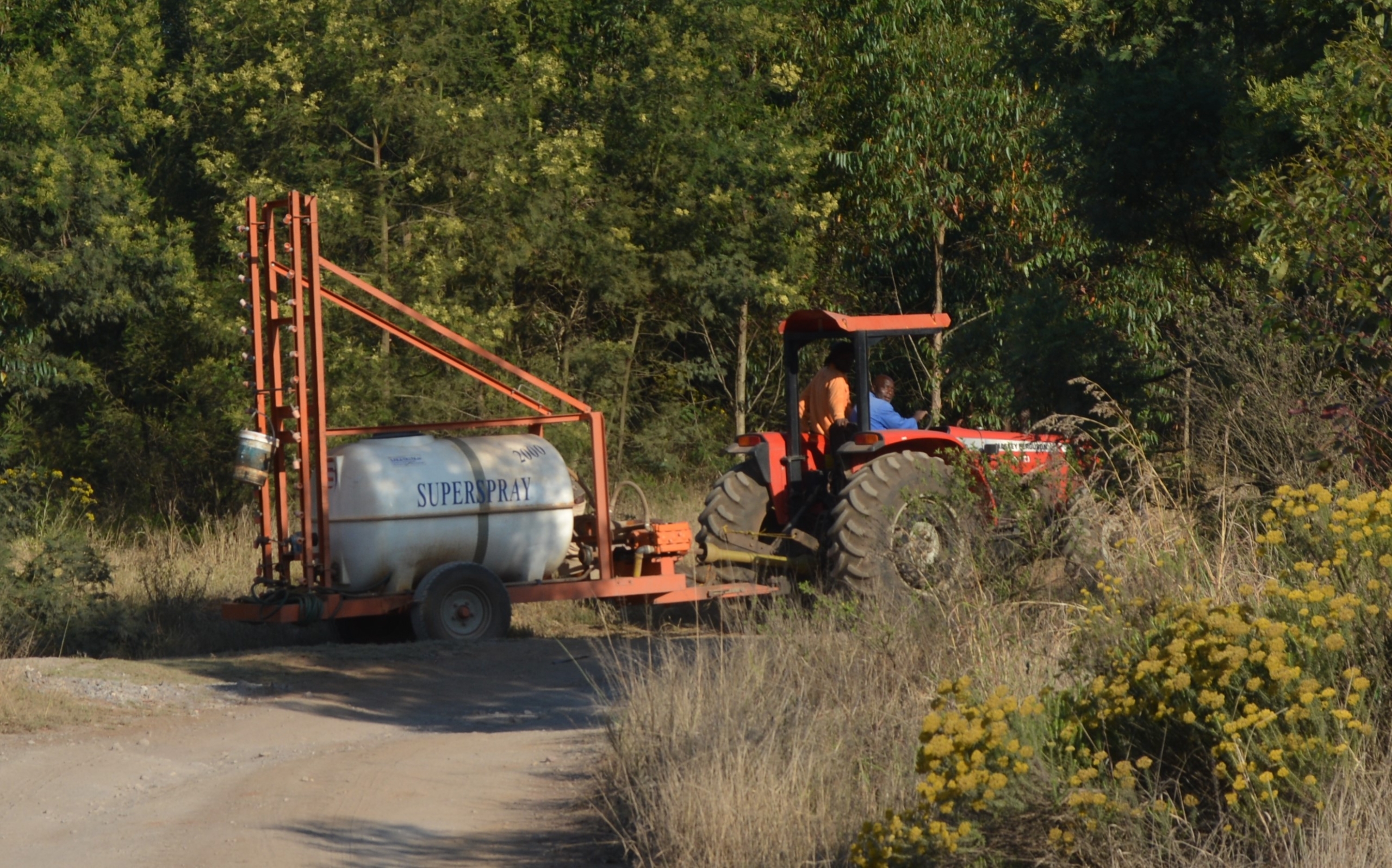
Spray Rig
IRRIGATION
Historically a “microjet’ man, Jaff has recently bought more into drip irrigation and explains this shift in the following points:
- Micros use more water than drip.
- More capital investment is required for micros than drip because the flow rate is higher. The blocks are therefore smaller, and the main lines are bigger. The bigger the main line, the higher the cost. Although pumps costs are not necessarily greater.
- Nutrients can be effectively and accurately administered through drip.
Ultimately, with drip, you can irrigate a bigger area, with less, more often which JAFF feels is better for the trees. Ever the questioner, I ask why you can’t just turn your micros on more often, for a shorter time but JAFF explains that, for him, that wouldn’t work because of the smaller blocks; he’d end up running around twice as much; it would be unsustainable.
JAFF explains that avos and macs don’t really feed beyond a 30mm depth so he would recommend 30min drip irrigation every day. Every 4th or 5th day he’d go longer so that the lower layers get some water but he’s unconvinced about whether this is entirely necessary.
With this season’s profuse flowering JAFF has adjusted his schedule to deliver less water more often in an effort to avoid any stress that would result in excessive flower drop. Sometimes he even irrigates twice a day; 45 mins in the morning and 10mins in the afternoon, especially if it’s very hot. These are 4 litre/hour drippers placed about 35cm apart.
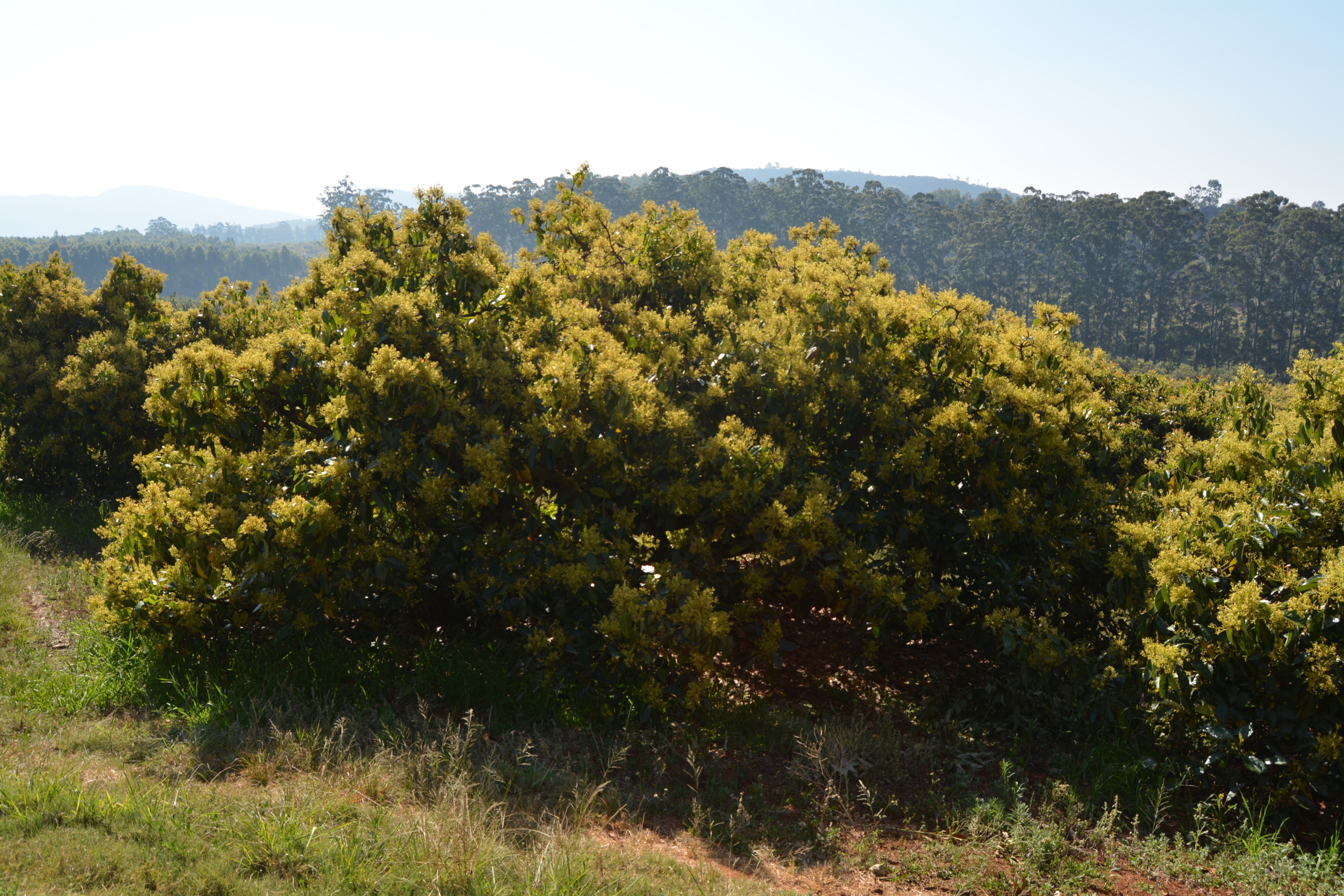
Very heavy flowering.
JAFF has about 7 or 8 probes across the farm. At a cost of R7000 each they’re not cheap but JAFF is really enjoying the insights these tools reveal. At 100mm depth, he’ll look at the steepness of the graph – if it dips steeply, the trees are drinking thirstily and he’ll know to watch closely and perhaps irrigate again. If it is less steep, he is happy that the trees are not too thirsty and he can maybe skip a watering. His system requires a manual turn on and off so it’s a challenge for the manager to do less, more often but JAFF firmly believes it is preferable to fewer, longer sets.

Note the probe, powered by a solar panel, on right hand side and new developments across the valley. JAFF also points out that he waited 6 years for the avo trees in the foreground. There was a stage when avo tree orders were taking this long to fulfil.
Water on the mountain is supplied by boreholes.
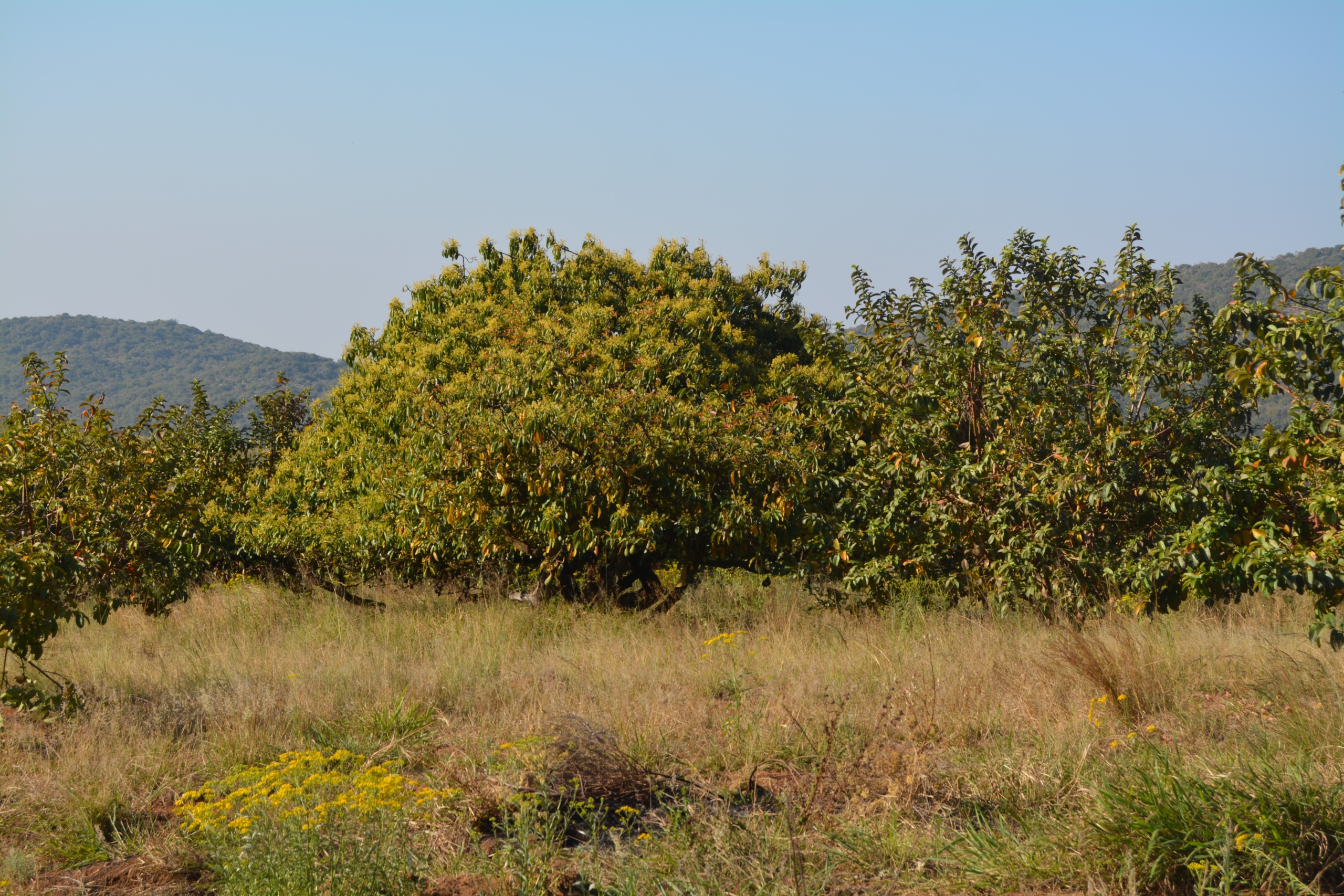
There is a vast area of dryland avos on a more remote part of the farm. They are interplanted with guavas which are only kept for nursery stock (motherwood).
PRUNING
(Warning: small detour through the macs) Behind the beautiful B&B on JAFF’s farm closer to town there was a young mac orchard. Having a deep fascination with these trees, I wondered through with my camera and coffee. The way these trees had been pruned was (weirdly ) beautiful. The central leader had been removed. Despite this 4-year-old Beaumont orchard having delivered 2 tonnes per hectare last season, JAFF had still had the foresight to prune for the future. The result was a wonderfully open tree, full of fresh air and sunlight. Looking forward to hearing how this orchard performs over the next few years.
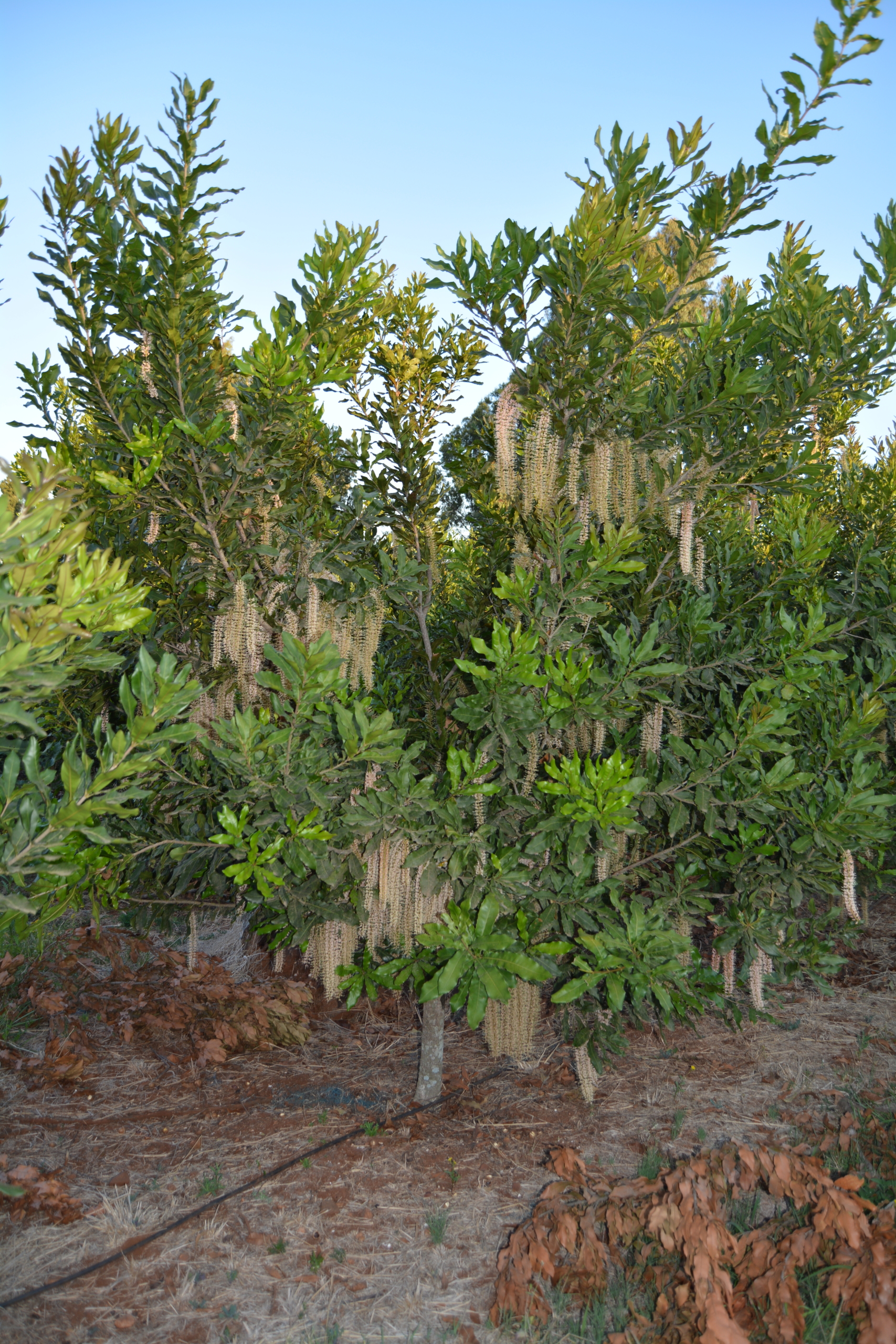
Okay – back to avos …
JAFF says you should start shaping an avo tree from about 2 years old, once it has developed some volume. The aim is to work towards a ‘teacup’ shape. This can be done by encouraging 4 leaders to develop along the outside. Height should always be controlled for spraying and harvesting.
JAFF was inclined to plant high density orchards as he sees the benefit in promoting a micro-climate that retains moisture and protects the soil but it does require additional maintenance as it can quickly become closed in, dark and stifled which is exactly what happened to one orchard in particular … When an avo orchard closes in it starts to grow UP and productivity drops. So JAFF, acutely aware that, with high density farming, you have to know when it’s getting away from you and when it’s time to thin out. So, he took up his shears and cleaned up. The following year (this year) saw a marked improvement in set, justifying JAFF’s drastic action. He also tried a new product on this orchard (more under NUTRITION) but muddied the results somewhat by applying it shortly after the major cut back.
Jaff doesn’t believe in skirting because of the protected micro-climate created on the soil surface by low branches; it helps keep the soil nice and cool and reduces water loss. In saying this, JAFF has an unfenced orchard where the bush buck insist on skirting his trees so high that all the ‘jewels’ are left exposed to the sun.
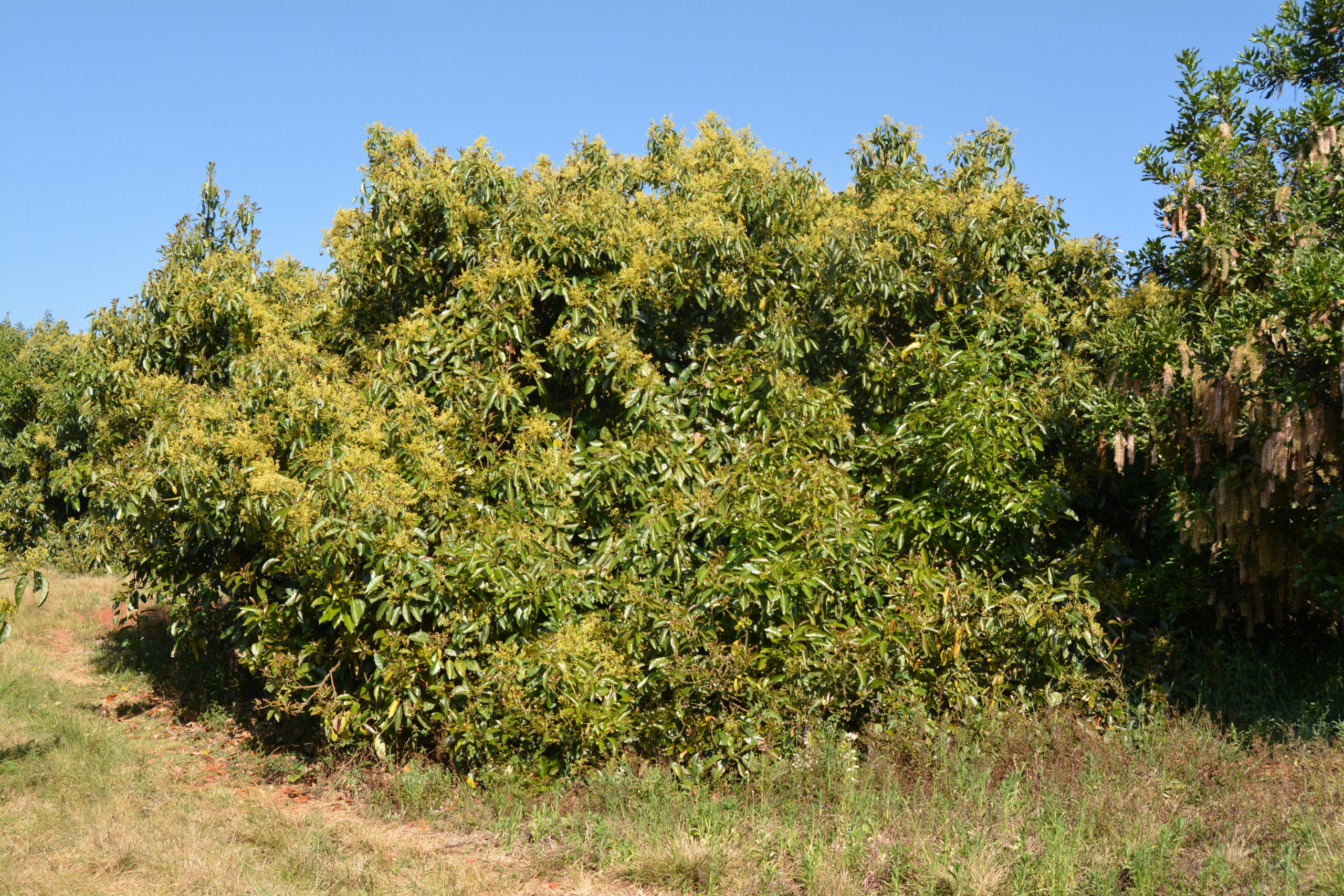
No skirting – clearly this tree is fenced.
JAFF adds that tree (branches) should always be painted straight after pruning to prevent sunburn. Unfortunately sunscreen on the fruit is washed away by rain too quickly to be a sustainable solution.
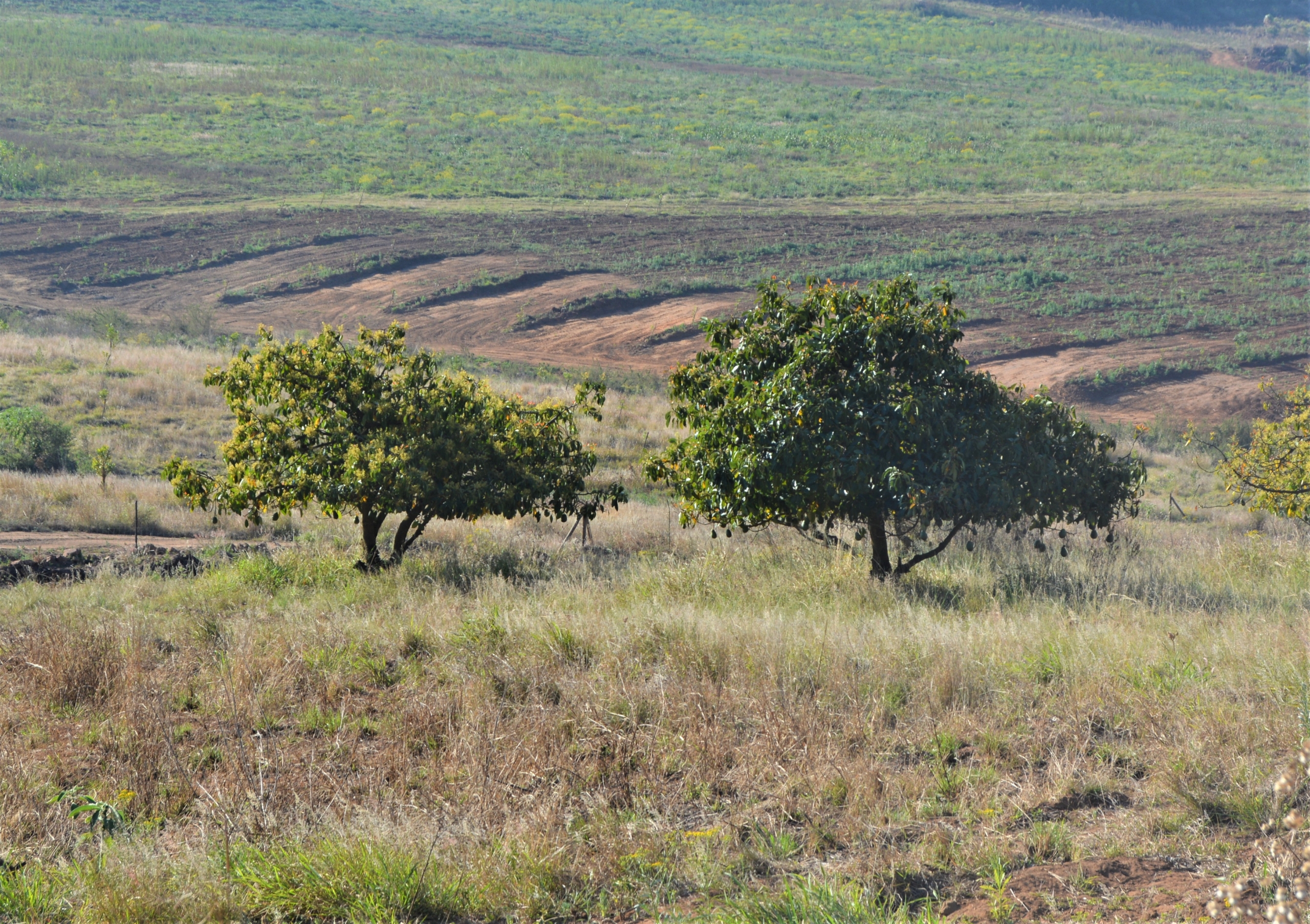
“Natural” skirting a la bushbuck.
The pic above and below is of an orchard of dryland avos planted in the 70s. JAFF says they’re more alternate, erratic bearing than their irrigated compatriots, who get more attention. The soil up here is also very sandy and full of rocks.
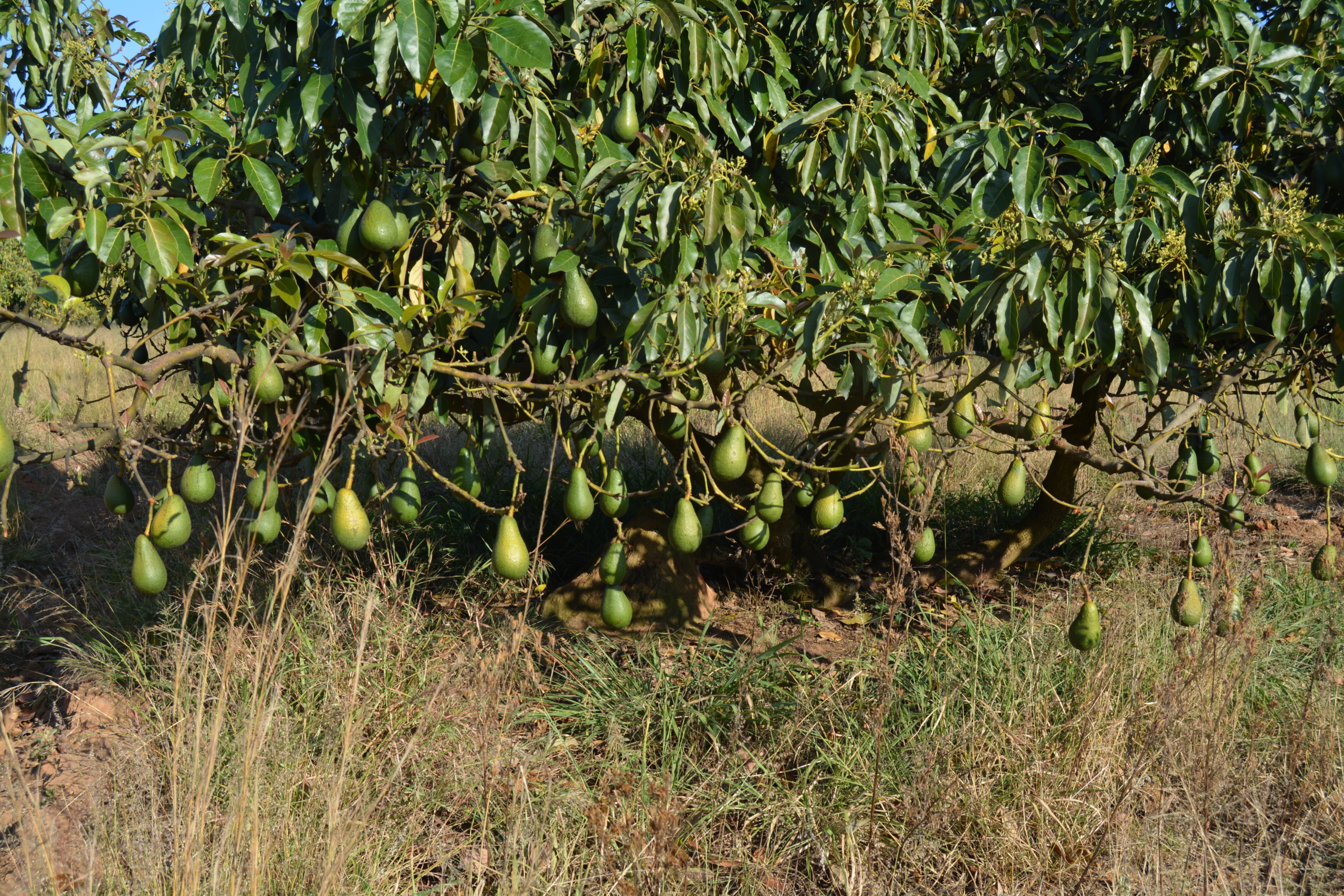
The bush buck eat the leaves and expose the avos to sunburn.
Porcupines are a real problem up here as well – they love avo-seeds (will leave the flesh) and mac nuts. They’ll also eat the avo roots and even ring bark the young trees.
What about fencing the bush buck out? JAFF says it’s a choice between that and getting the new developments done, “For now, I’m focused on getting the new developments done,” he settles it with.
NUTRITION, CHEMICALS & SOIL HEALTH
Fundamentally, JAFF is a ‘greenie’ and kicks off this discussion by saying, “The more beneficial fungus (life) in the soil, the better because it improves nutrient absorption.” He adds that carbons in the soil need to be high as well and that’s why composting and mulching are so important, “This awareness about carbon is a relatively new thing but is vital to sustainable soil health.” His view is based on the Peg wheel approach to managing phytophthora and he follows all 8 recommendations as closely as possible.

Peg Wheel
Basically JAFF believes that the more rich and diverse the soil life, the less you will struggle with phytophthora, but he is not adding any supplementary life to the soil currently – it is on his ‘to-do’ list though.
JAFF uses three measurements to help him assess nutrition requirements:
- Soil content
- Leaf content
- Soil Moisture
He is closely watching how the technology around assessing leaf sap is developing as well.
He has a few tips around nutrition:
- Sulphur is important for the uptake of calcium – without it calcium is restricted to the tree.
- Nitrogen should be supplied cautiously as excesses can be detrimental. JAFF’s was measuring 2.56, 2.17, 2.42 – all of which is way too high. He advises that it should be below 2, especially on a fuerte avos. JAFF explains that supply in excess of what the tree needs not only wastes resources, it also promotes vegetative growth and can affect fruit quality adversely.
- Avo roots are not as efficient or resilient as those of macadamias. They are susceptible to disease and require an exceptionally healthy soil environment.
- Once a tree’s flush starts hardening off, the energy will be rediverted, back to the roots. Farmers should balance and time nutrition accordingly; and supplement with additional phosphates when roots are flushing.
- Remember that phytophthora doesn’t show on the stem of avos like it does on macs where it can be seen as a cancerous breakdown of the cambium. In avos, the damage is only visible on the roots.
JAFF had a pricelessly simple way to calculate how much fertiliser to give each tree. At this point, it is important to note that, when it comes to avos, JAFF farms each individual tree.
How much to feed each tree:
JAFF’s simple methodology takes 3 factors into account:
- Size of the tree (based on tree diameter)
- Health of the tree (based on a visual assessment of poor, average or good)
- Crop the tree is carrying/expected to carry (based on low, medium or high)
Practically, it works off the table below together with an adjustment based on the size of the tree:
| CROP/YIELD | ||||
| HIGH | MED | LOW | ||
| HEALTH/VIGOUR | HIGH | 100% | 75% | 50% too vigorous |
| MED | 75% | 100% | 125% | |
| LOW | 150% | 125% | 100% | |
Another way of using the same formula is as follows, in conjunction with the application rate per tree size below that:
| Health/Vigour | ||||
| High | Medium | Low | ||
| Crop/Yield | High | A | B | C |
| Medium | D | E | F | |
| Low | G | H | I | |
| Grams per tree | ||||||||||
| A | B | C | D | E | F | G | H | I | ||
| Meters | 2 | 110 | 138 | 165 | 83 | 110 | 138 | 55 | 83 | 110 |
| 3 | 248 | 309 | 371 | 186 | 248 | 309 | 124 | 186 | 248 | |
| 4 | 440 | 550 | 660 | 330 | 440 | 550 | 220 | 330 | 440 | |
| 5 | 688 | 859 | 1031 | 516 | 688 | 859 | 344 | 516 | 688 | |
| 6 | 990 | 1238 | 1485 | 743 | 990 | 1238 | 495 | 743 | 990 | |
| 7 | 1348 | 1684 | 2021 | 1011 | 1348 | 1684 | 674 | 1011 | 1348 | |
| 8 | 1760 | 2200 | 2640 | 1320 | 1760 | 2200 | 880 | 1320 | 1760 | |
| 9 | 2228 | 2784 | 3341 | 1671 | 2228 | 2784 | 1114 | 1671 | 2228 | |
| 10 | 2750 | 3438 | 4125 | 2063 | 2750 | 3438 | 1375 | 2063 | 2750 | |
| 11 | 3328 | 4159 | 4991 | 2496 | 3328 | 4159 | 1664 | 2496 | 3328 | |
| 12 | 3960 | 4950 | 5940 | 2970 | 3960 | 4950 | 1980 | 2970 | 3960 | |
So, a tree with a diameter of 10m would get 2750grams of fert before crop and health are factored in. But, if the health of the tree is clearly poor and it is carrying a heavy crop, it will get 150% of that dose. i.e.: 2750 x 150% = 4125 grams.
JAFF laughs, “Some people think I am crazy that I am fertilising per individual tree.” His fertilising lady does the measurements, assesses the tree and applies accordingly. JAFF will start tracking the results of this intense programme by recording results on a GPS-guided programme.
Credit to Prof Walstenholme for this fertiliser application table.
Besides fertiliser JAFF applies as much compost as possible and has a regular supply of baobab husks to keep his piles high. To this he adds anything organic including chicken manure, kraal manure, wood chips, mac husks and prunings. This takes about 2 to 3 years to break down.
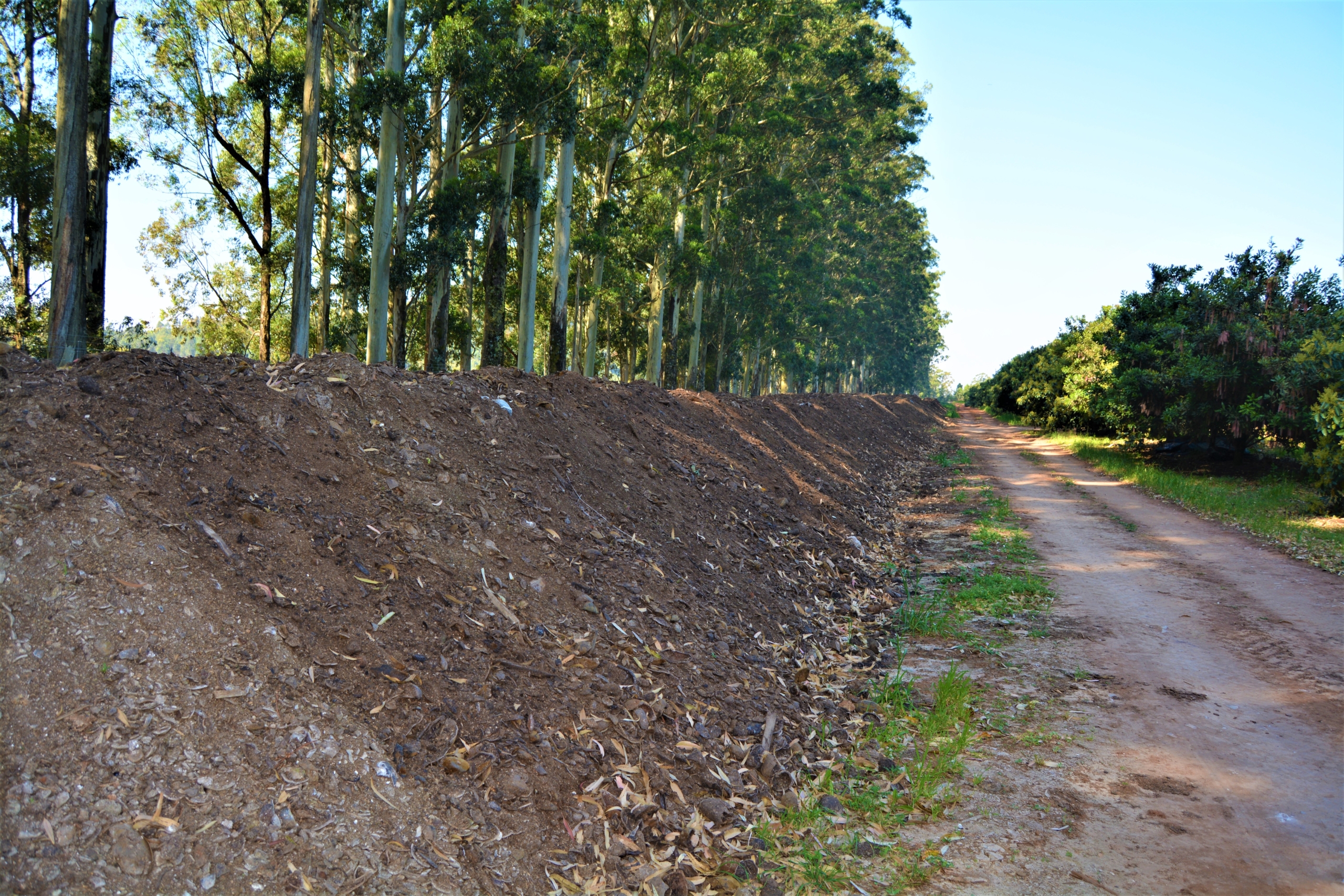
Extensive piles of compost
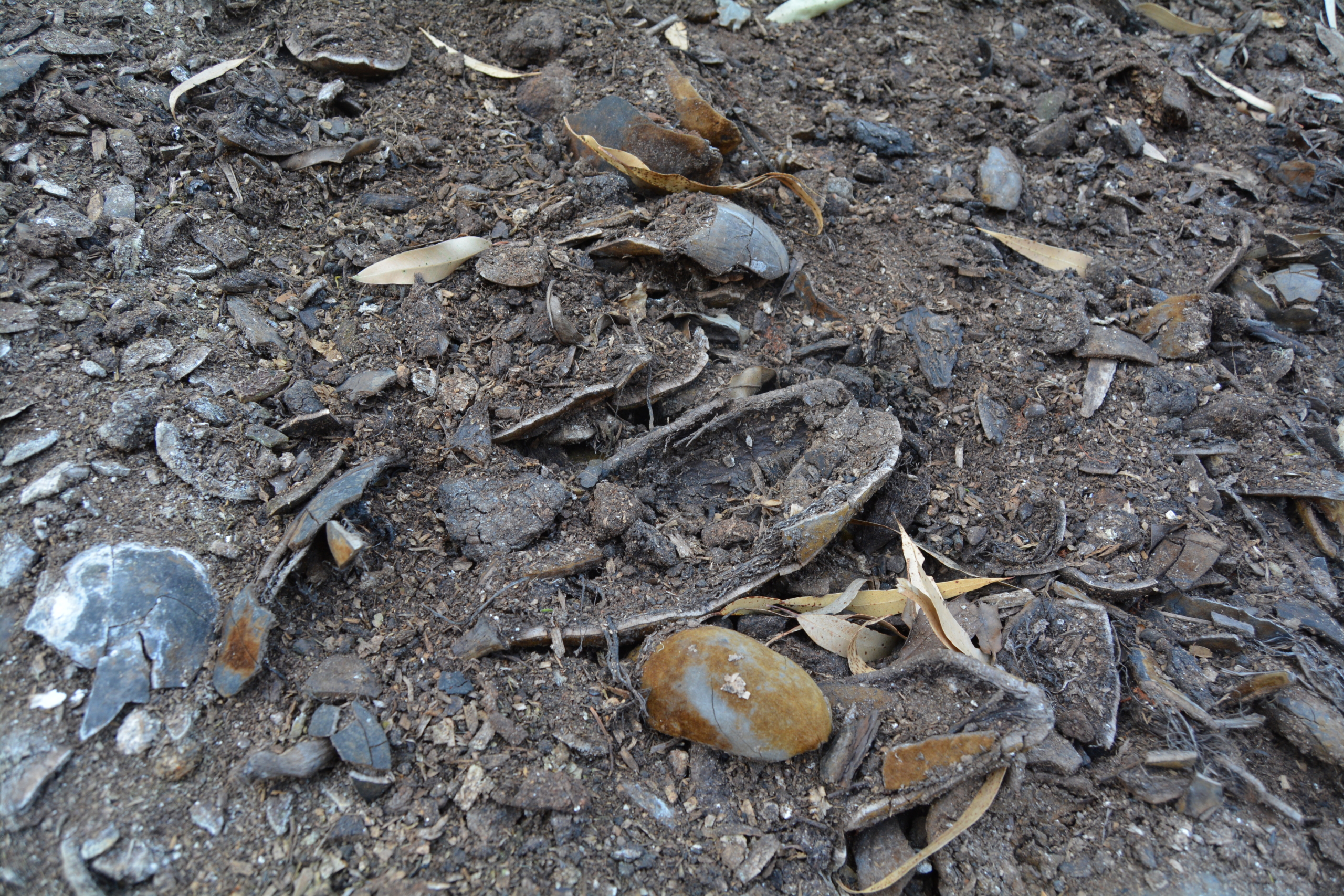
Lots of baobab husks
Something else that has captured JAFF’s interest lately is a chemical promoted by a agronomist consultant originally from Lebanon, with vast experience built up throughout Africa, The promise for avos is that it will promote flowering, rather than vegetative growth.
He then has another chemical that will apparently encourage all these flowers to set. It all sounded too good to be true and I was sceptical but JAFF used it this year and says the set has been amazing but, he says, “I also pruned this orchard very heavily after last season and can’t be sure whether all the fresh air and sunlight should be taking credit for the set and the fact that N was removed from applications.” Either way, he’d like to continue trialling this new product.
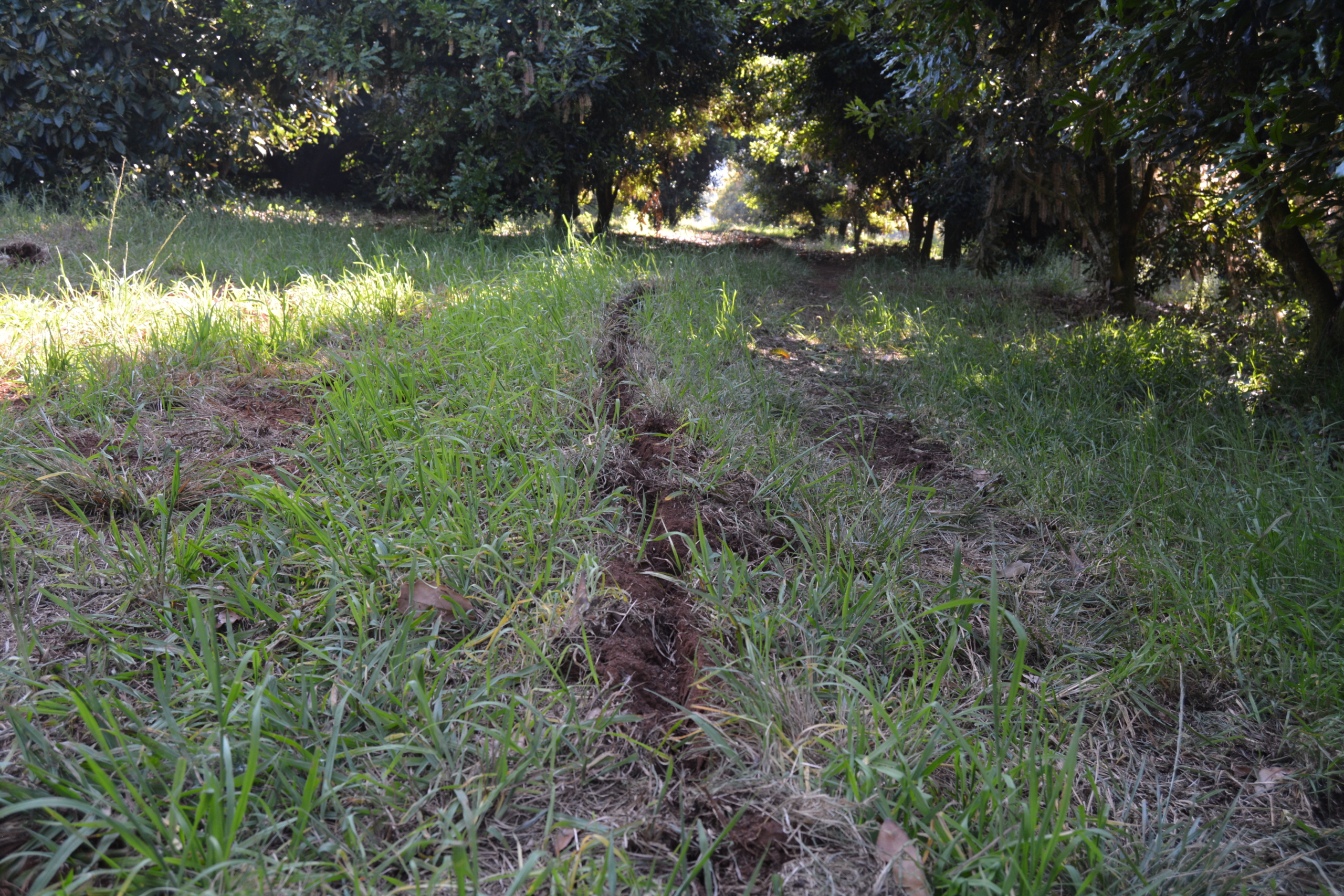
Ripped interows – 1,2m deep – JAFF will broadcast gypsum to improve calcium levels
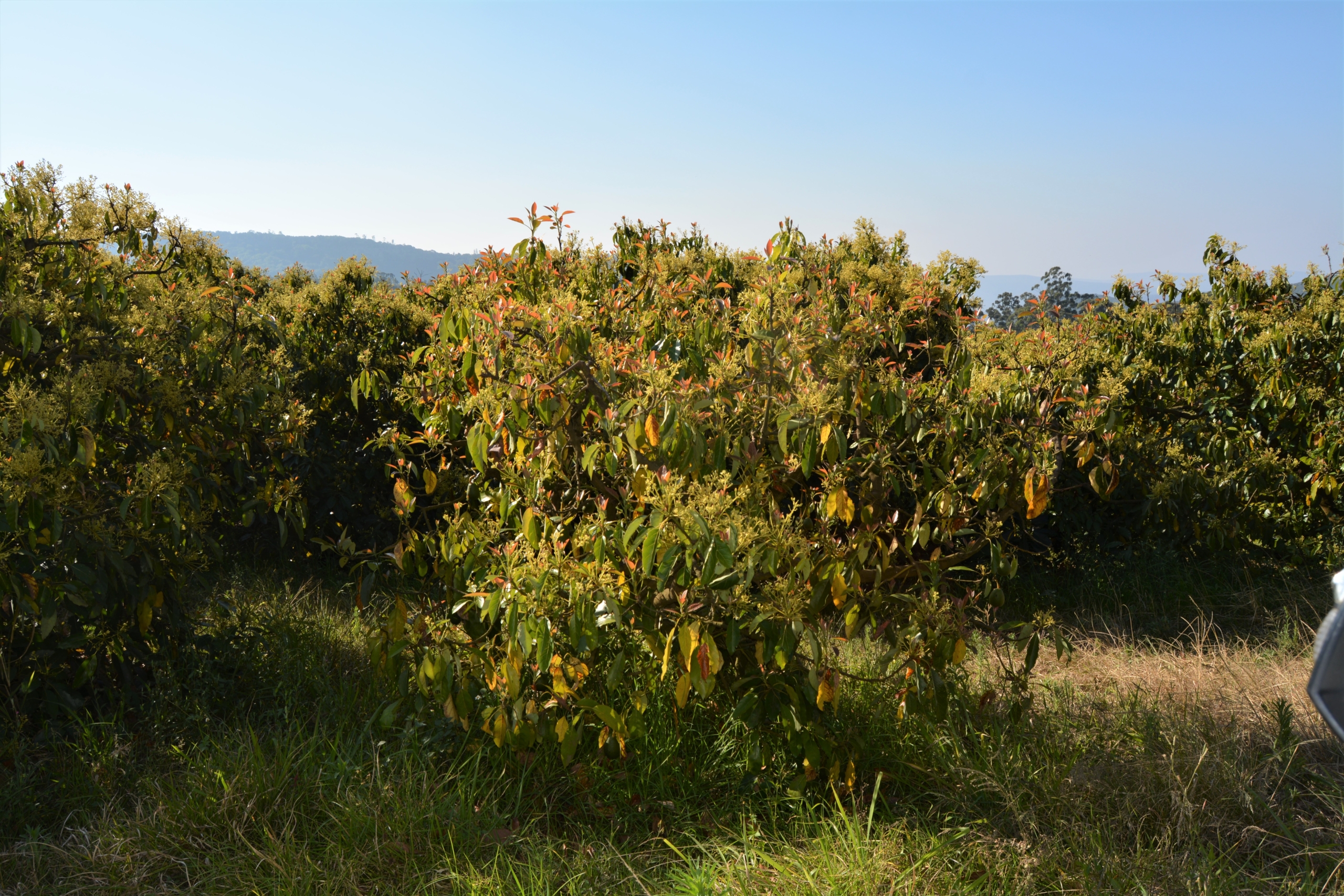
A sick tree. JAFF has struggled with these fields since the topsoil was removed by an errant bulldozer operator prior to planting. The low organic content is gradually being addressed with additional compost.
YIELD
I’m still ‘learning’ avos and was curious to understand what’s considered good when it comes to avo yields. “22 tonnes/hectare in SA is brilliant,” says JAFF, “but I have heard that Kenya can get up to 40 tonnes/hectare.” What’s happening in Kenya? JAFF explains that apparently Kenya has a very high carbon content in their soils; perhaps because they haven’t been farming commercially for as long. Their soils are between 3 and 4% carbon whereas ours are around 1% carbon.
According to the agronomist supplying the flowering and setting potions, the best way to improve carbon levels is with kraal manure. Together with organic material this will support healthy microbial life. Unfortunately, animal waste doesn’t go down well with Global Gap but luckily JAFF is not an exporter, and therefore doesn’t have to worry about that! He’s glad he’s supplying South Africans who have far more tolerance for natural waste.
So, what’s JAFF getting? Seems he’s been on a bit of a roller coaster … 2/3 years ago it was 12 to 14 tonnes/hectare then it dipped to half that. Last year it went up again … he thinks the variance is largely due to weather fluctuations.
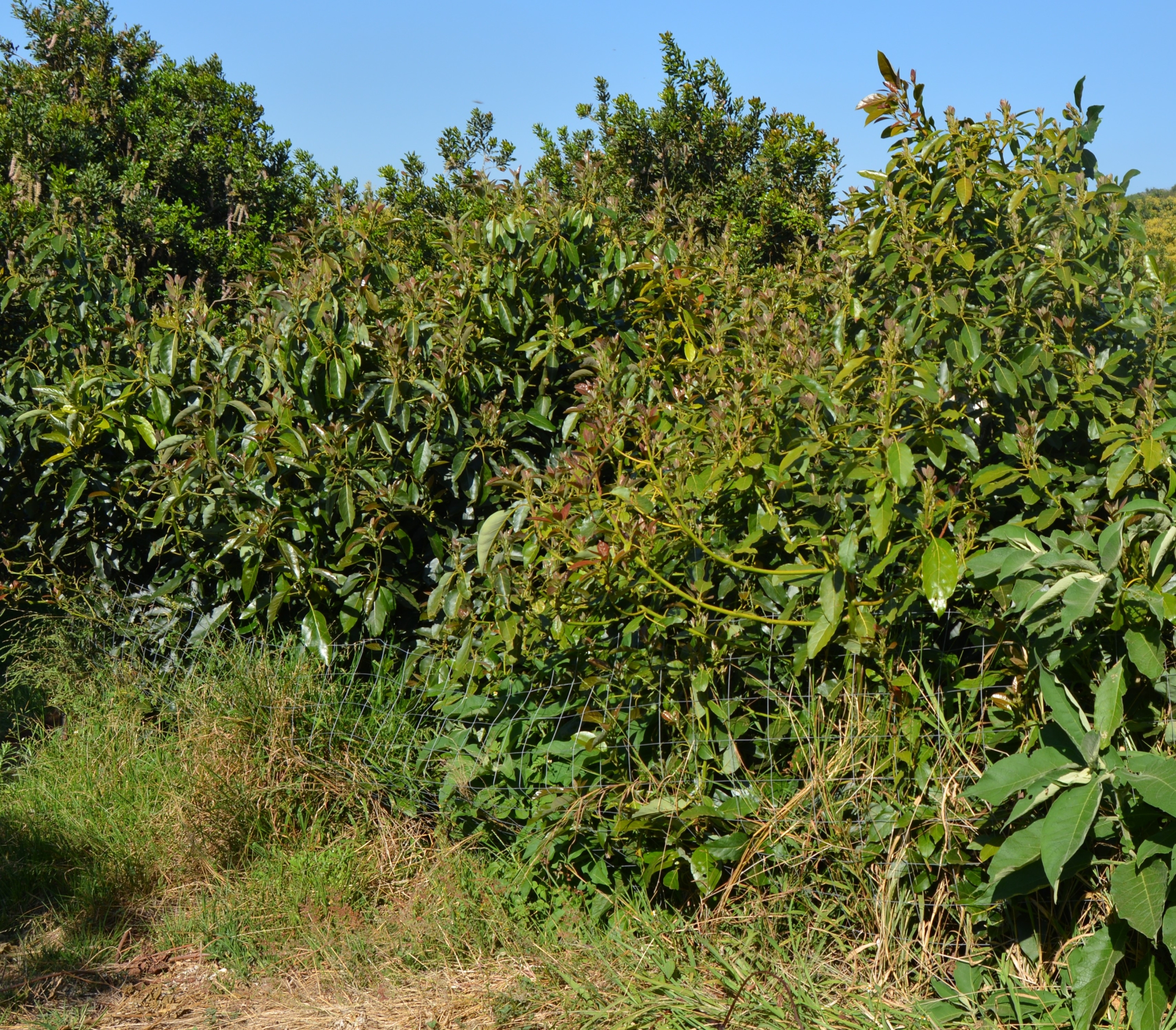
Some trees were performing very badly. Supposedly Fuertes but JAFF was not convinced. He stag horned them, and top-worked the regrowth with good motherwood. Fenced to keep the bush buck out. Was successful; only lost 2 out of 40.
And with that came the end of my interview with JAFF and my stay in Louis Trichardt … the wheels needed to turn and I was off to Levubu.
Below is a picture of my favourite seat in the Cuckoo’s Nest Guesthouse. Thank you JAFF, for the privilege of staying at your lodge – it honestly is one of the best places I have ever stayed at and I was very sad to leave. To TropicalBytes readers; if you ever have an opportunity, treat yourself: https://www.cuckoosnestguesthouse.co.za/
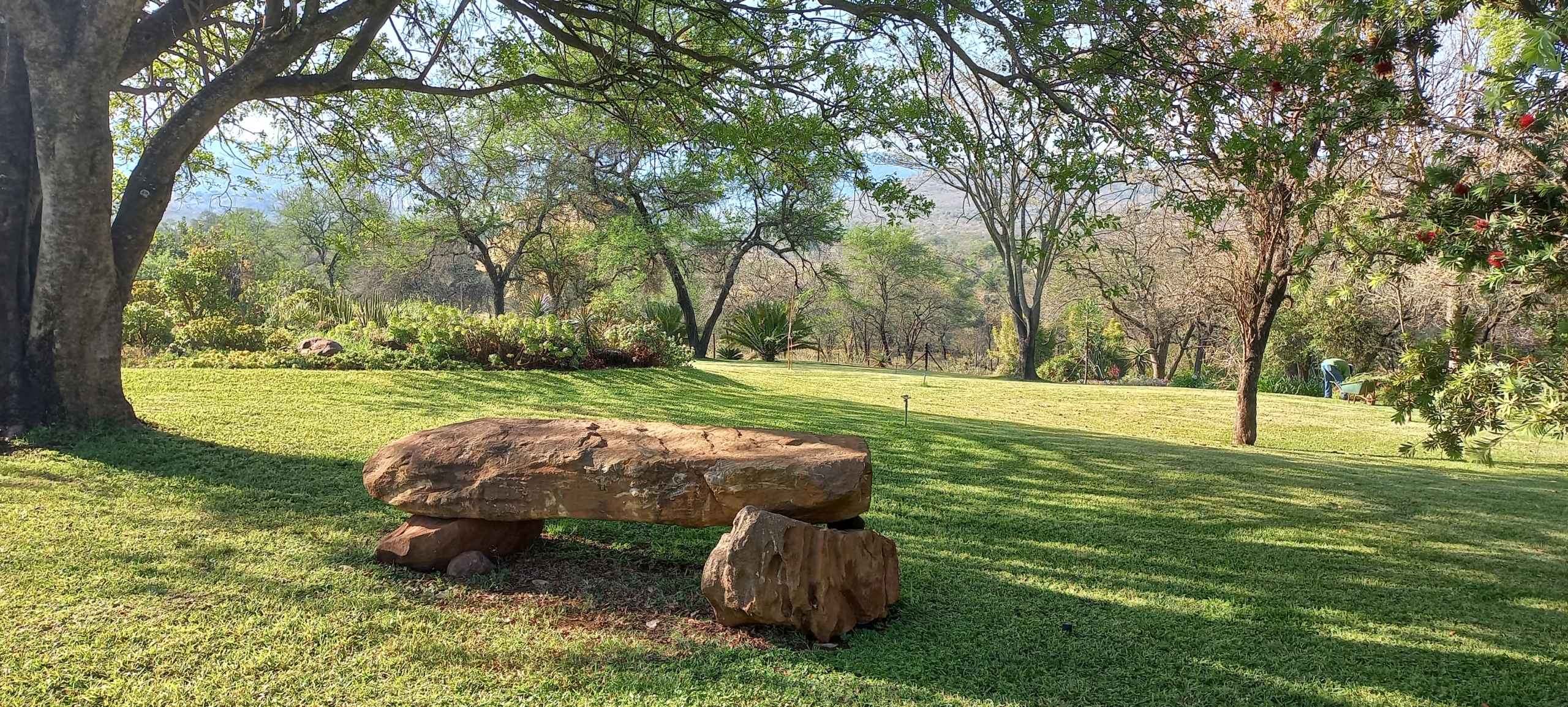
To JAFF, it was an honour to meet you and enjoy some of your wisdom. Thank you for sharing so openly and patiently. I look forward to visiting again.
BIBLIOGRAPHY
agric.wa.gov.au

